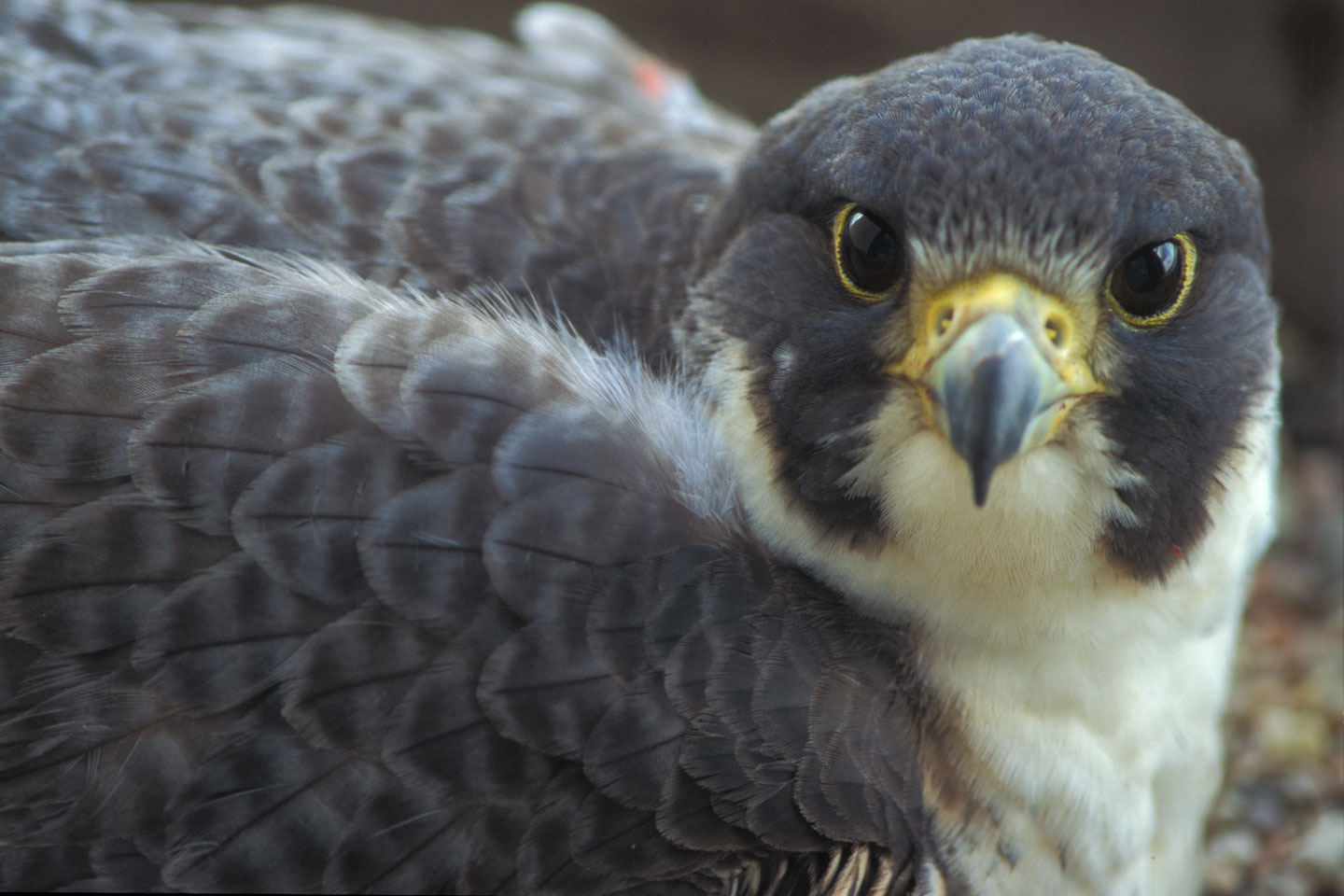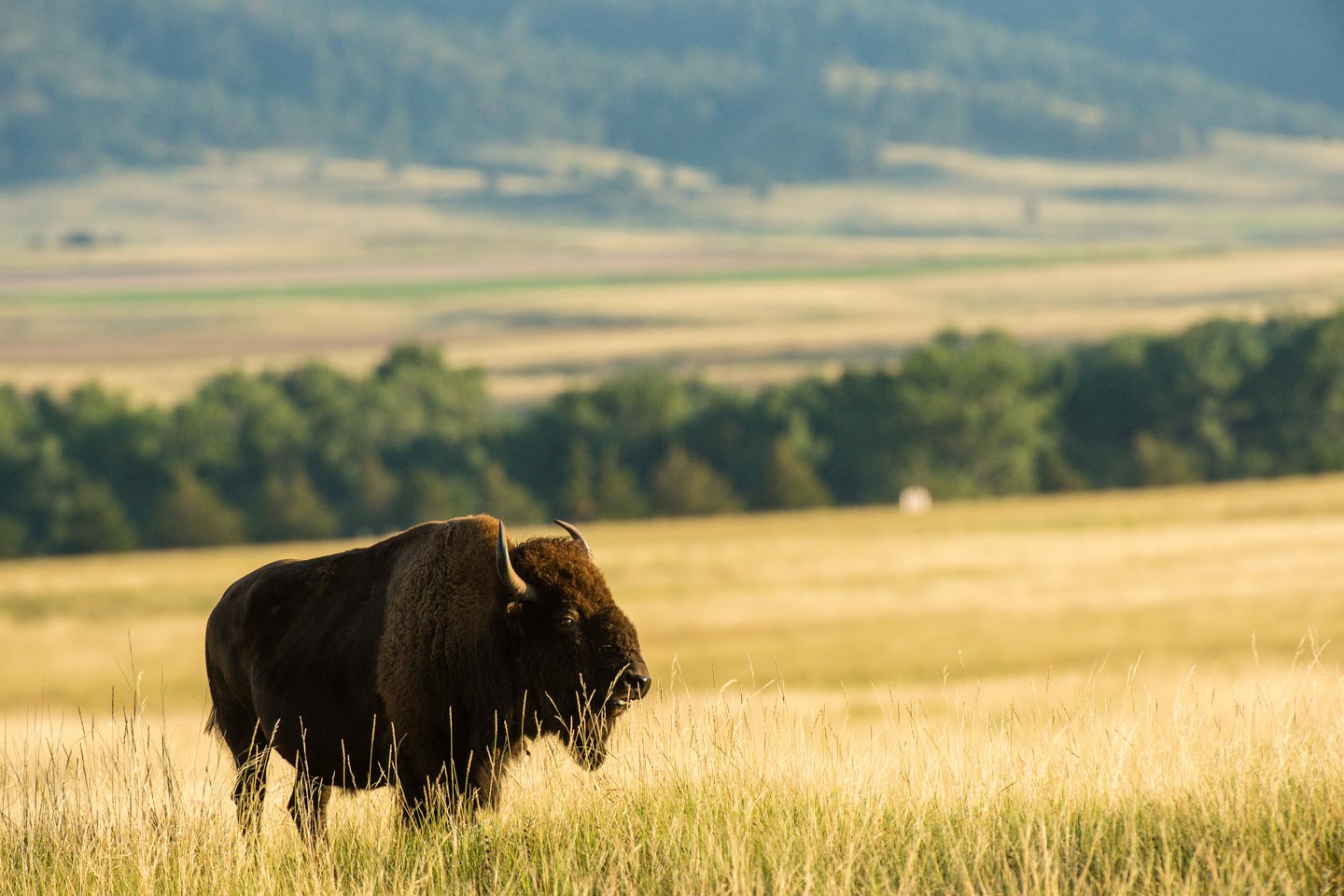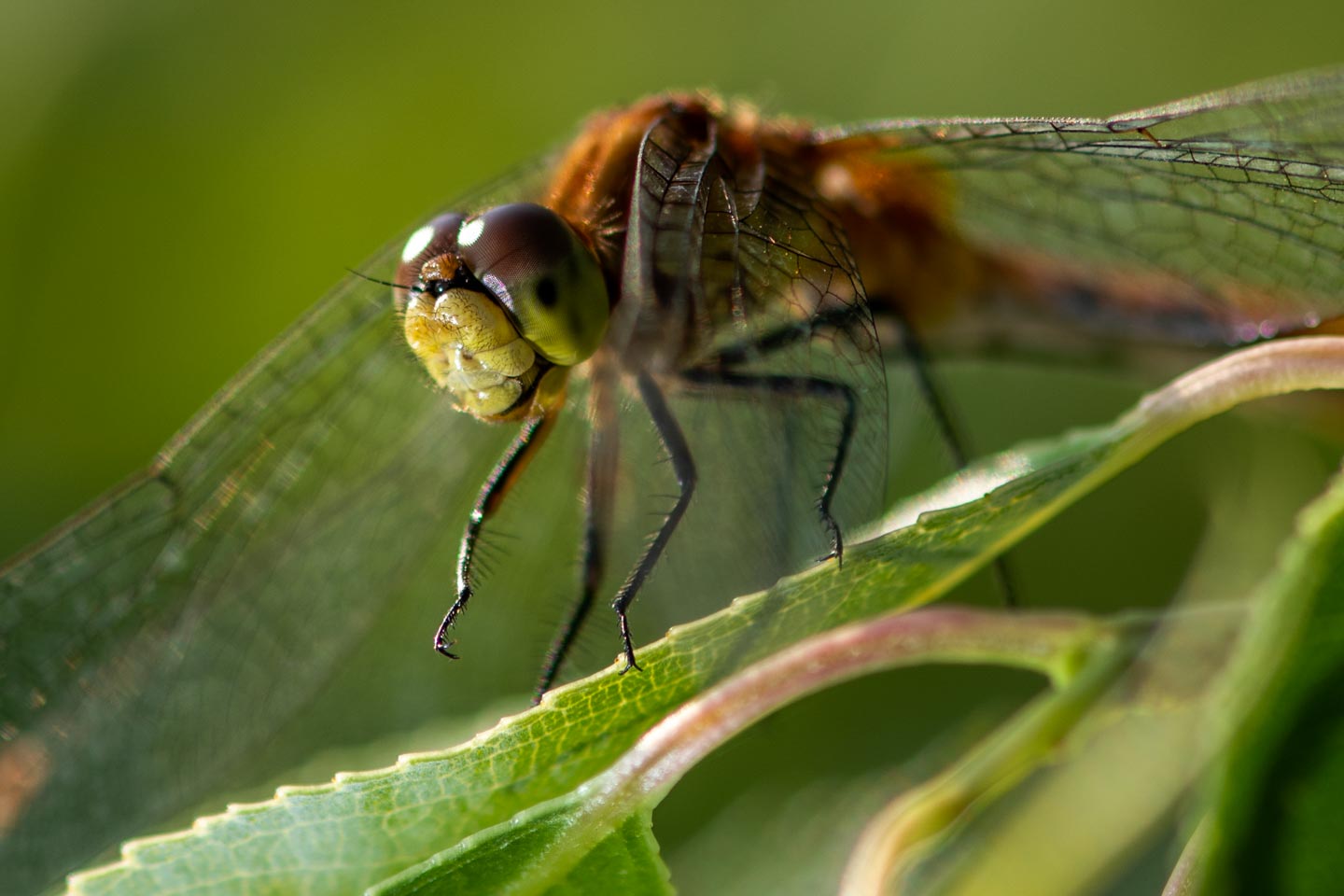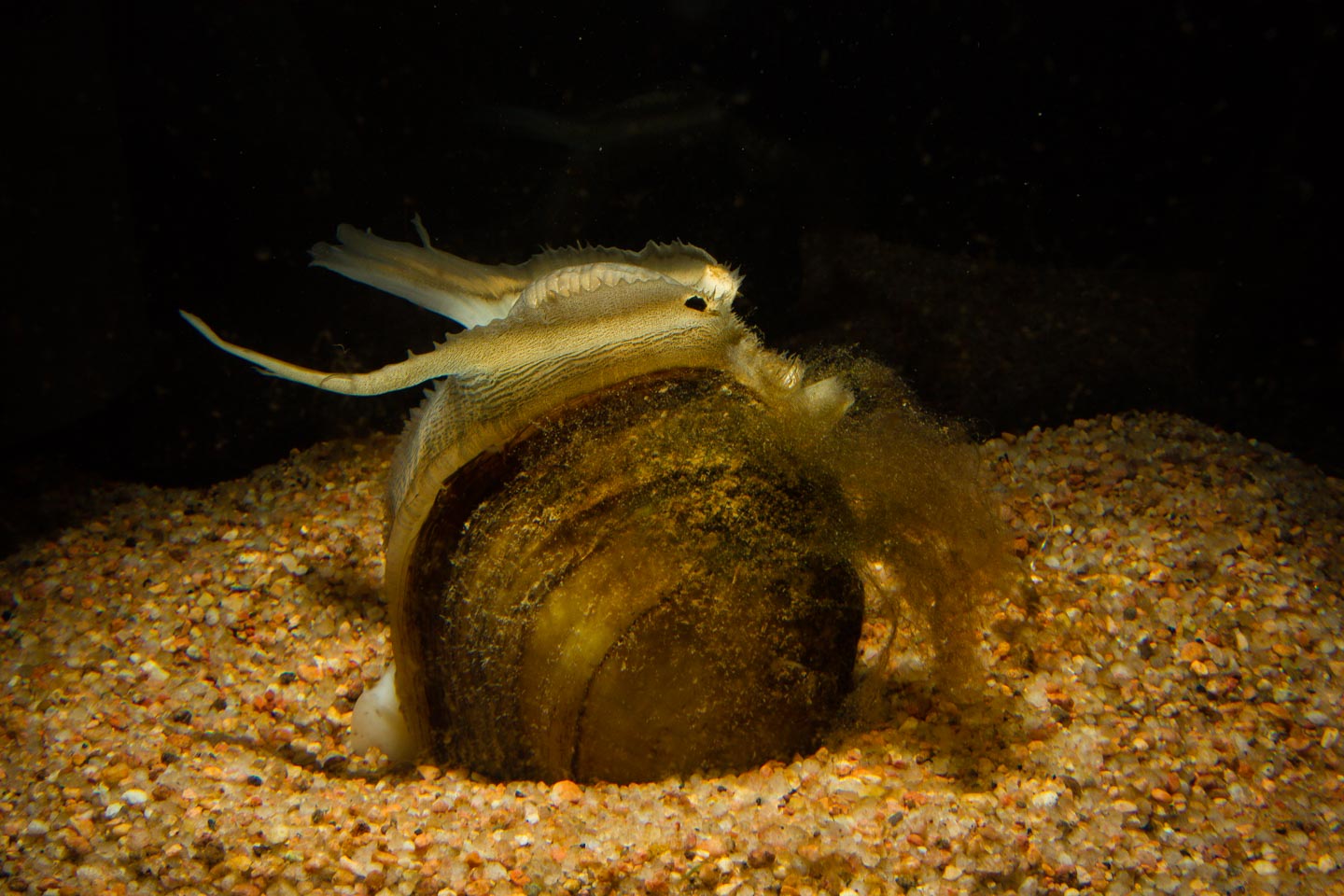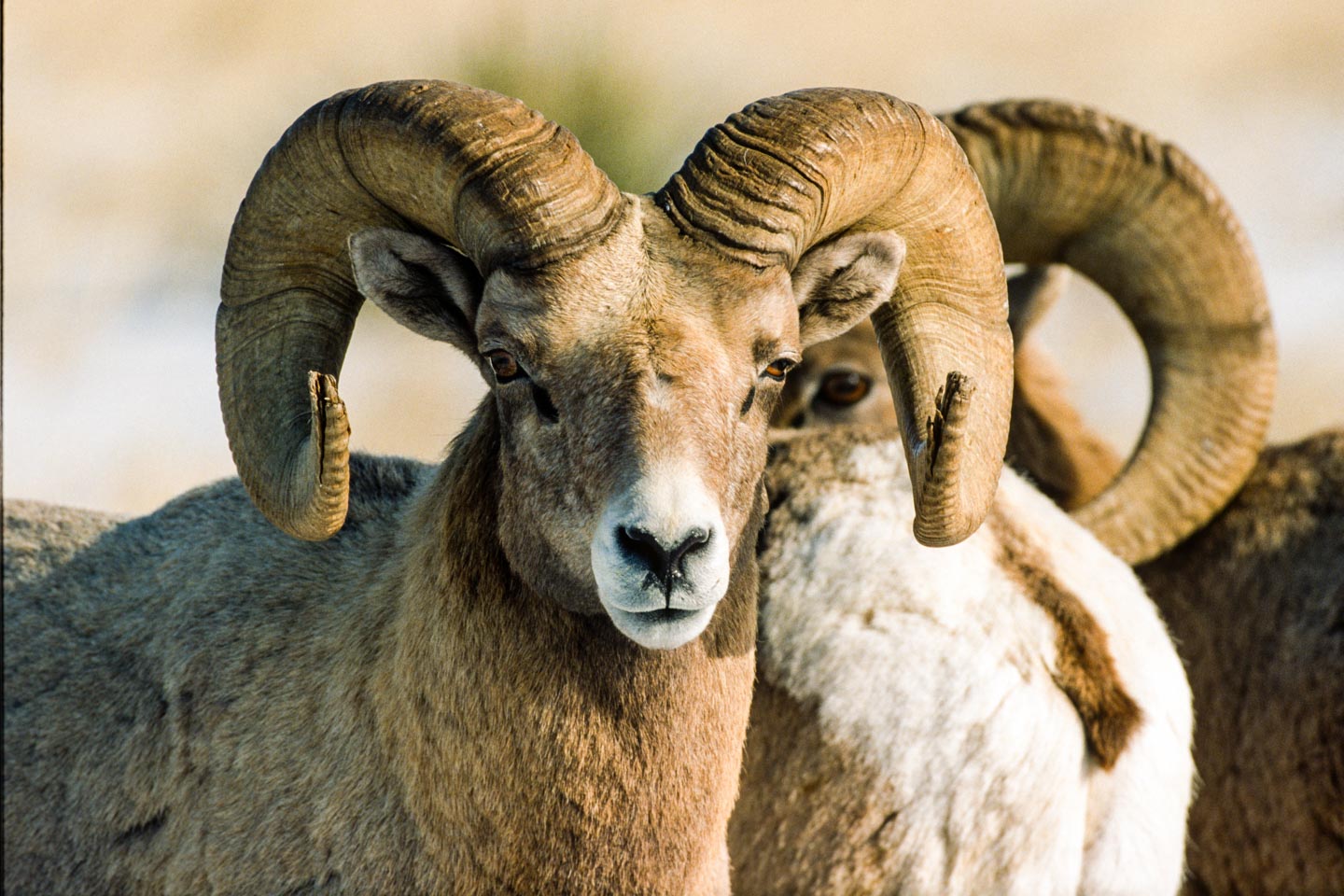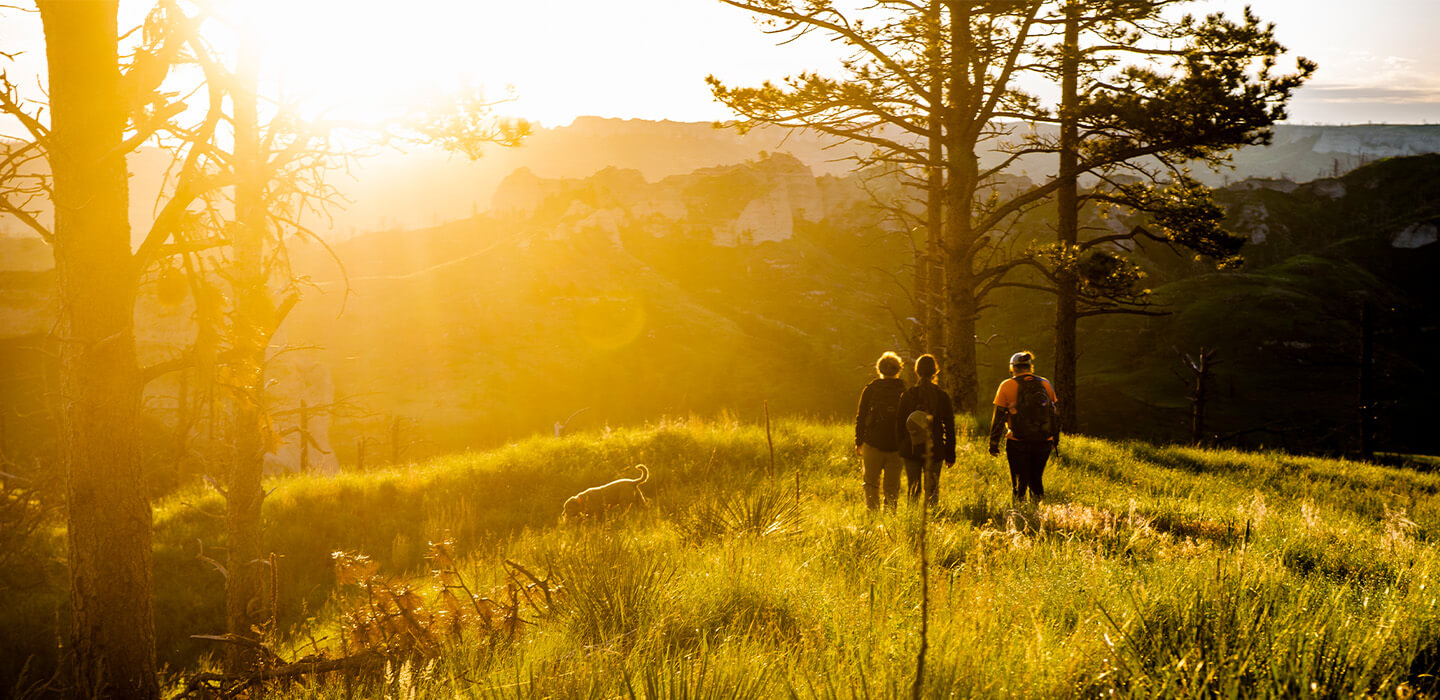Snakes
Nebraska is home to 29 different snake species — 25 that are non-venomous and 4 that are venomous. Some are found statewide, others just in sections of our state. These animals are members of the reptile family tree, which also includes turtles and lizards.
Snakes species in Nebraska
Dive into the world of snakes, discovering what each species in Nebraska looks like, where it’s located, what it eats and other fun facts.
Non-venomous
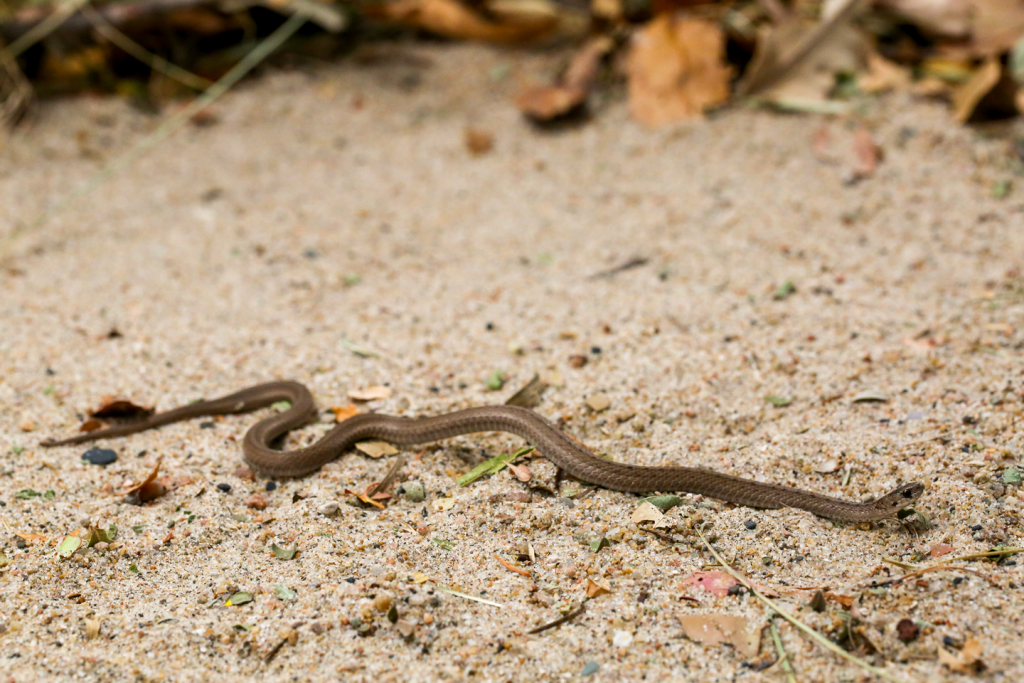
Physical description
The brown snake, also known as DeKay’s brownsnake, varies greatly in coloring and pattern. The base color for this snake is a brown to reddish brown or even gray with light colored stripes bordered by black dots. Some snakes have been found to have the black dots on both sides of the body with a thin black line, or even yet other snakes have had no pattern at all. Sometimes they are solid colored with random black flecks. The top of the head is usually black, and there is either one or two dots around the neck area in the back. The belly of this snake is either white or light gray.
Size
Adult brown snakes reach anywhere from 9-13 inches long.
Habitat
This snake can be found along streams, moist woodlands with brushy habitats. They are a frequent visitor in backyards and trash dump sites. They can be found underneath logs, boards, and rocks.
Range in Nebraska
This snake is limited to the southeast corner of the state.
Diet
The brown snake feeds on snails, slugs, and earthworms.
Fun Facts
>> These snakes have been found under logs with ice still surrounding them.
>> On warm spring days you can find these snakes on low hanging branches and brush along streams, searching for their food.
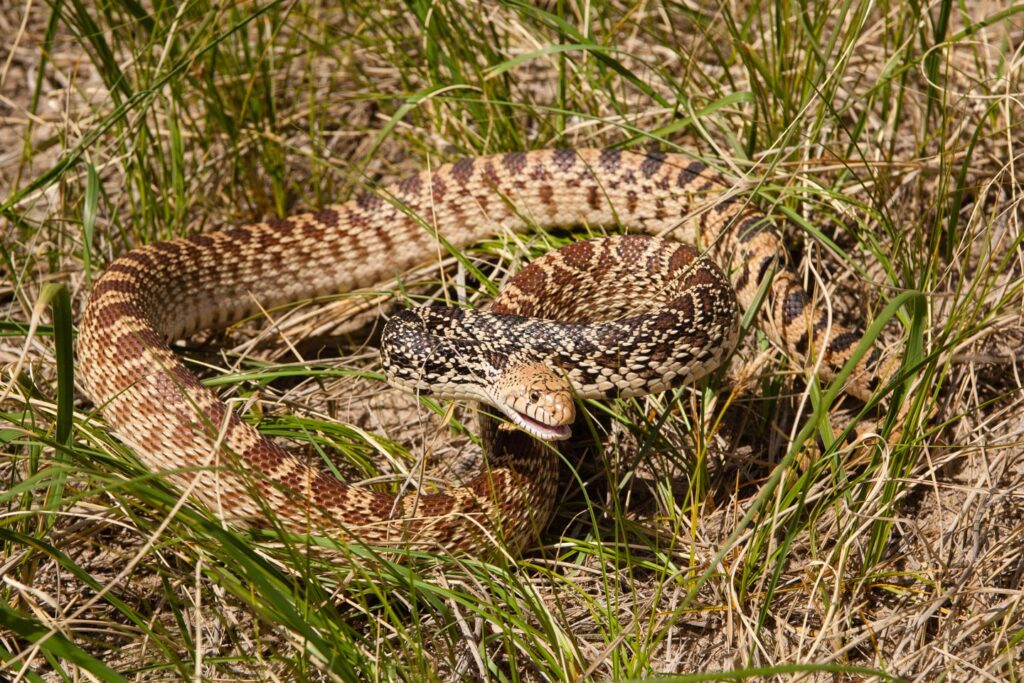
Physical description
This is Nebraska’s largest snake! In Nebraska, bullsnakes are normally a yellow color with black, brown or reddish blotches down the length of the snake. In western Nebraska, these snakes are normally a lighter color than those that live in the eastern part of Nebraska. Their belly color is yellow with black squares. The head shape is extremely triangular with a black band that extends from the corner of the eye to the mouth.
Size
This is Nebraska’s largest snake, ranging from 40-70 inches long.
Habitat
Bullsnakes inhabit sandy prairies and grasslands throughout Nebraska. They also can be found in areas with rocky outcrops.
Range in Nebraska
Bullsnakes can be found throughout the state of Nebraska.
Diet
Being larger snakes, these animals can feed on large and small rodents, rabbits, birds and bird eggs. These snakes are also known to eat waterfowl eggs as well.
Fun Facts
>> Like other snakes, bullsnakes will rattle their tail when disturbed or threatened. These snakes will also exhale through their open mouths that makes a loud hiss like sound, similar to a rattlesnake.
>> Bullsnakes will normally hibernate in abandon prairie dog and badger burrows.
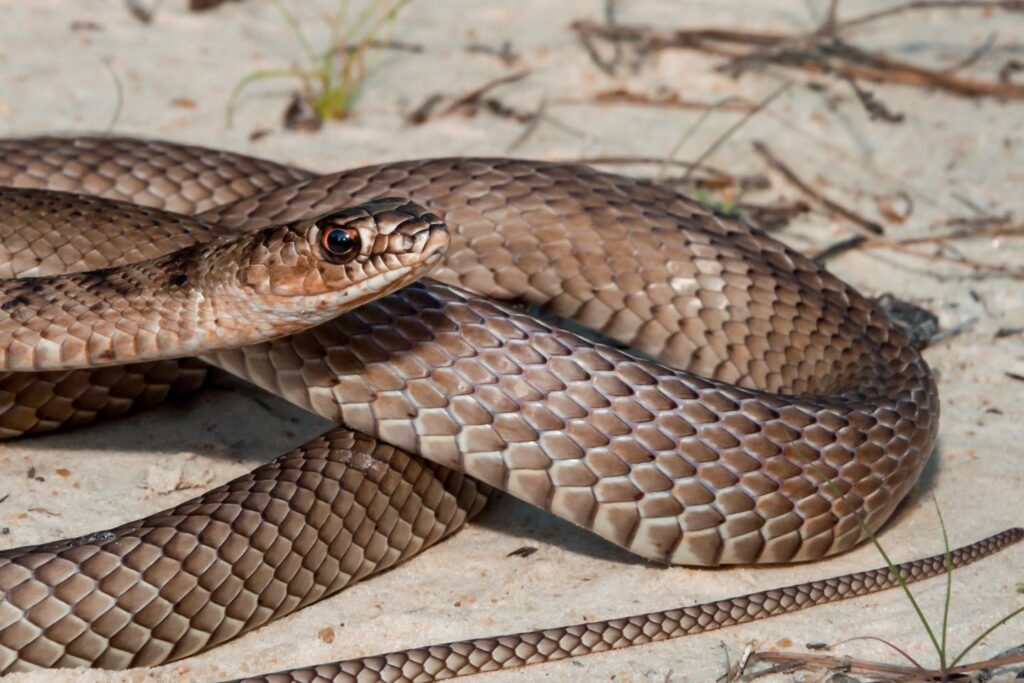
Physical description
Depending on where this snake is found, will determine the color. In their eastern range of Nebraska they are normally a dark brown to black color towards their head, and then will change to a light brown to tan towards their tail. In the western range they are almost exclusively light brown or tan. Young snakes will be a light brown to reddish color and could have dark bands on their heads.
Size
Coachwhips are large snakes ranging in size from 40-60 inches.
Habitat
These snakes prefer open areas such as grasslands, savannas, scrub and sagebrush prairies and other kinds of open mixed grassland habitats.
Range in Nebraska
These snakes are found in the extreme southwest region of Nebraska.
Diet
These snakes will eat small mammals, birds and bird eggs, lizards, other snakes, and small turtles. Young snakes will often eat large grasshoppers, and other invertebrates.
Fun Facts
>> These snakes are excellent climbers and can be found frequently in bushes and trees.
>> Rather than using a sit and wait strategy, the coachwhip will actively hunt their prey using the same periscoping technique as the eastern racer.
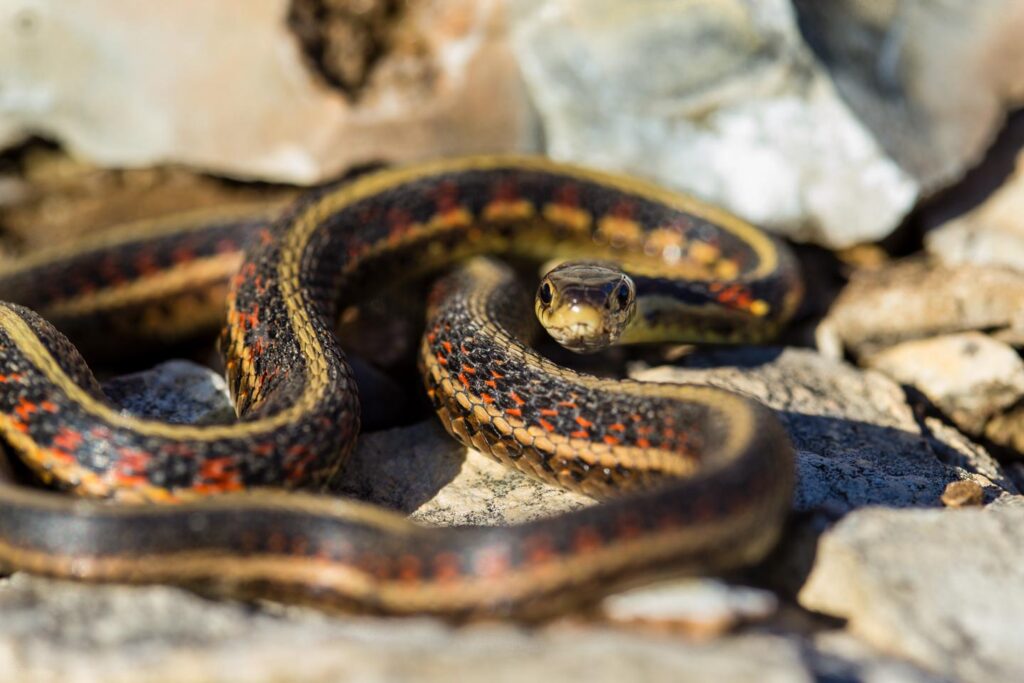
Physical description
This species of garter snake varies greatly in color and pattern. This snake is often referred to as the red-sided garter snake. Normally a brown or black snake with a bright yellow stripe down the middle of the back. This snake also has a bright red and black checkerboard pattern down the length of the snake. The belly of this snake is normally a yellow or creamy white color.
Size
Adult common garter snakes can reach lengths of 22-32 inches long.
Habitat
This snake is found in almost every possible habitat including; stream sides, prairies, woodlands, and city backyards. Commonly they are found in areas with permanent or temporary bodies of water.
Range in Nebraska
These snakes can be found throughout the state of Nebraska.
Diet
Common garter snakes will feed on fish, amphibians, earthworms and small mammals.
Fun Facts
>> These snakes normally enter hibernation in October, but will often emerge on warm days after that to bask.
>> Common garter snakes are considered active every month of the year in Nebraska.
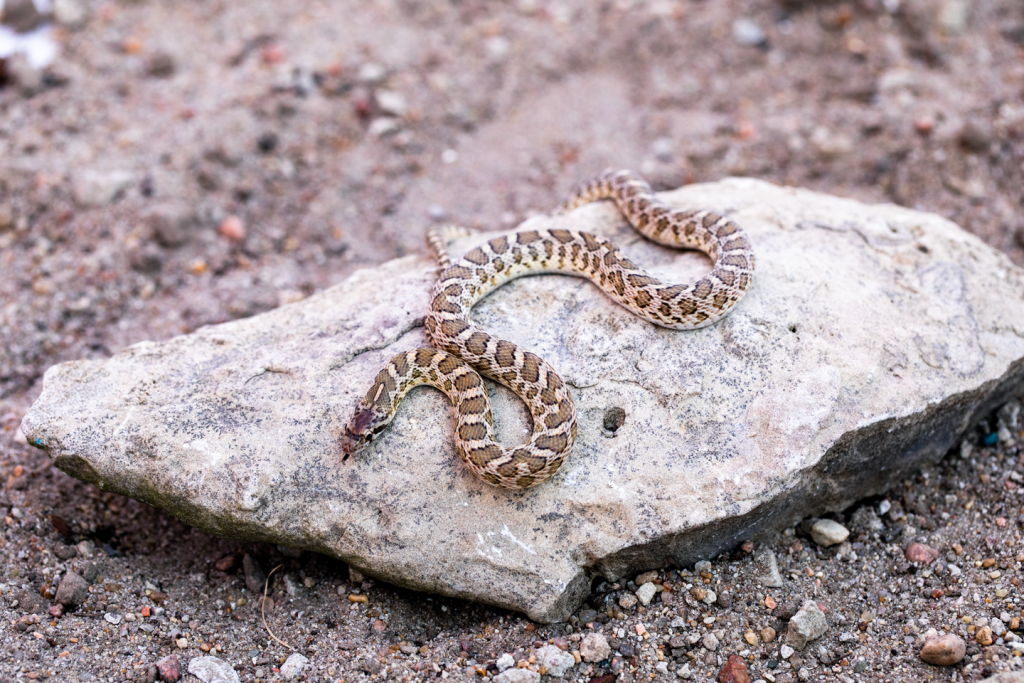
Physical description
The eastern glossy snake is a fairly large sized snake, normally a light gray color or a dark brown color with black blotches down their back. This snake’s belly is usually a creamy white color with no pattern. The eastern glossy snake gets its name from their shiny looking scales, which appear to be “glossy.”
Size
Adults range in size from 25-40 inches long.
Habitat
These snakes can be found in mixed and shortgrass prairies where there is sandy soil and small amounts of plants and forbs.
Range in Nebraska
The eastern glossy snake has only been found in three counties in Nebraska; Dundy, Hitchcock and Thomas county.
Diet
This snake is a constrictor and feeds on small rodents and lizards.
Fun Facts
>> This snake is considered fossorial, meaning they spend a considerable time underground, thus to aid them in maneuvering in the dirt they have a relatively small head compared to the rest of their body.
>> In Nebraska, the eastern glossy snake is considered rare, so they are listed as a species of concern.
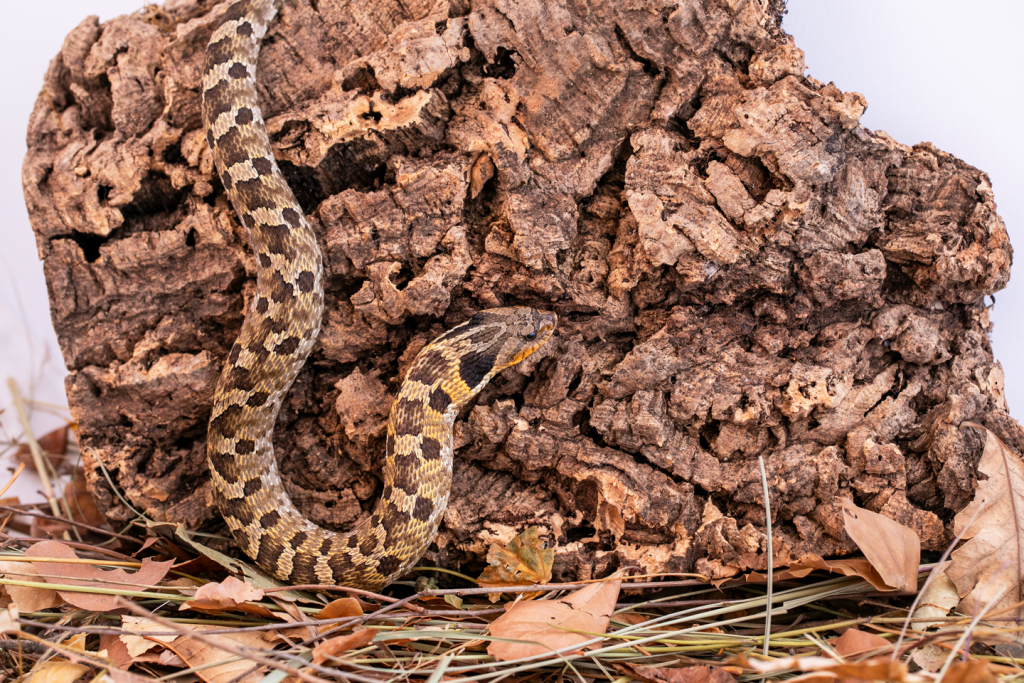
Physical description
Similar to its cousin the western hognose snake, this snake also has an upturned scale, that acts as its “nose.” These snakes vary in color from a gray, yellow, light brown, dark brown, or black. Some snakes will then have dark brown blotches down their back, or these snakes can have no pattern whatsoever.
Size
The eastern hognose snake normally reaches 30-35 inches as an adult.
Habitat
These snakes are found in the eastern side of Nebraska along river floodplains and riparian woodlands. They also can be found in grasslands with sandy soils. These snakes prefer areas where there is little vegetation.
Range in Nebraska
These snakes can be found sporadically throughout the eastern two-thirds of the state.
Diet
The Eastern Hognose snake almost feeds on frogs and toads exclusively.
Fun Facts
>> This snake is sometimes called the “spreading adder” as it will flare out its neck skin, similar to a cobra.
>> This snake is rear-ranged and can produce a mild venom which it will deliver to its prey.
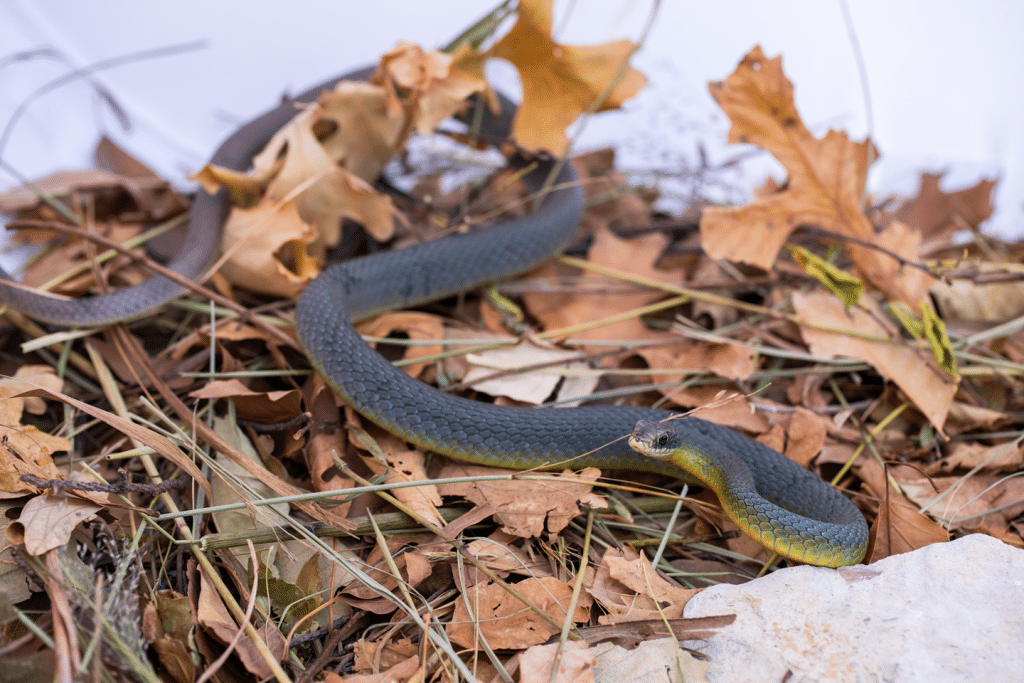
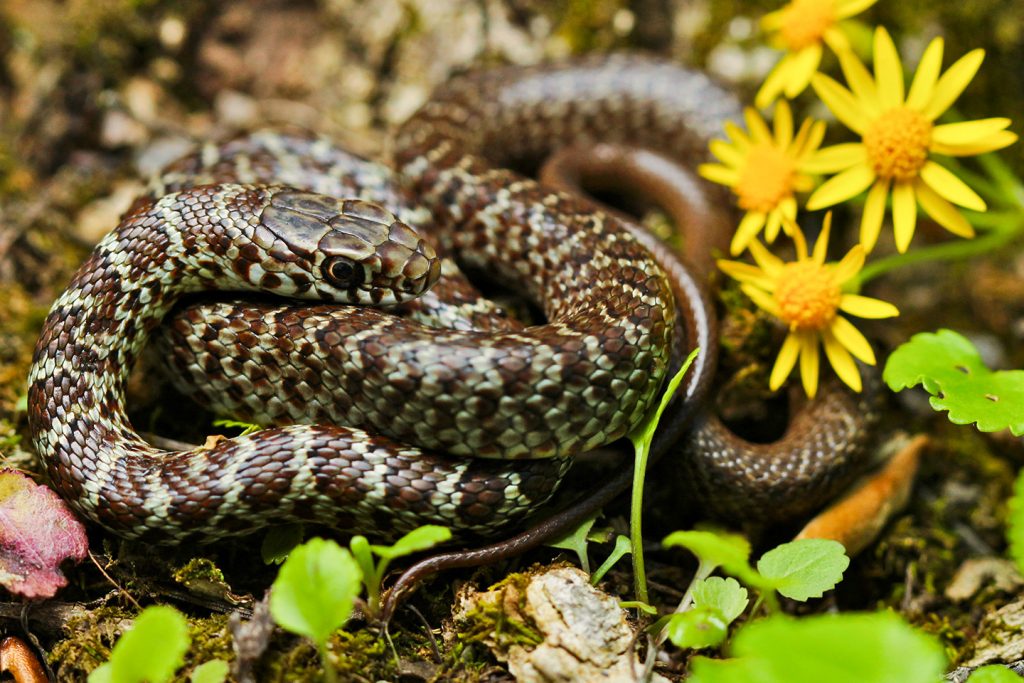
Physical description
Eastern racers are slender snakes that as adults are normally an olive green to greenish blue color. However, as juveniles they have heavily patterned dark reddish brown blotches which they retain through at least their first year of life.
Size
Adult eastern racers range between 25-55 inches long.
Habitat
This snake can be found in a variety of habitats including; grasslands, croplands, open woodlands, and even human dwellings like houses and buildings.
Range in Nebraska
The Eastern racer can be found throughout the state of Nebraska.
Diet
Prey for the eastern racer includes; birds and eggs, other snakes, lizards, insects and small mammals.
Fun Facts
>> The eastern racer exhibits periscoping behavior, which simply means they move through grasses with their heads raised searching for food, similar to a periscope.
>> During extreme temperatures they will take refuge in small mammal burrows and often hibernate with several other species in the same location.
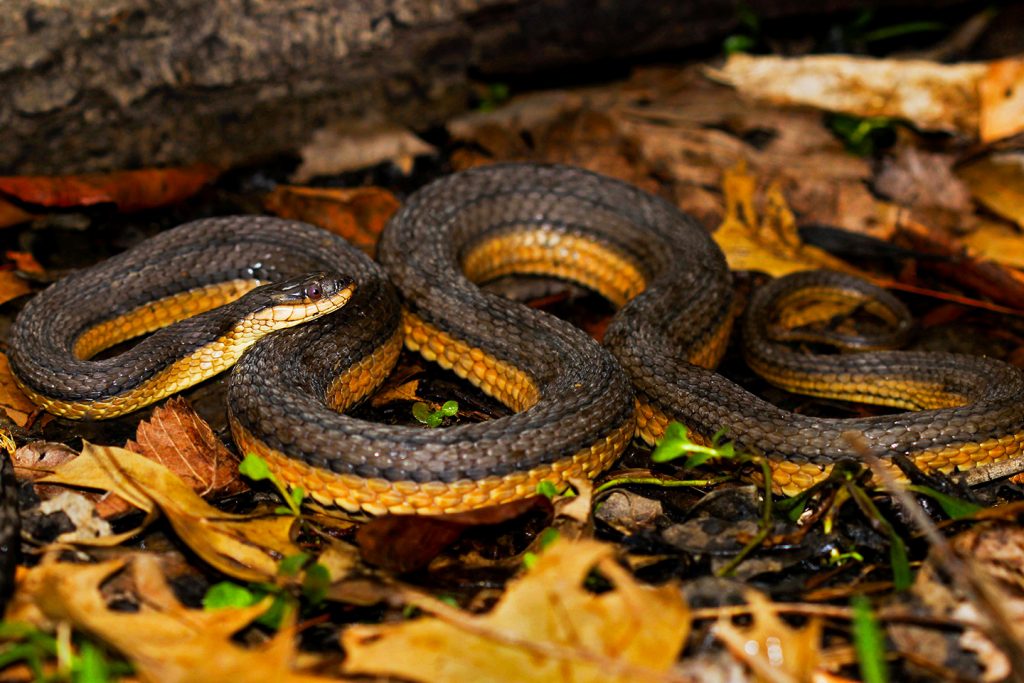
Physical description
Graham’s crayfish snake is a light brown to olive colored snake with dark stripes down the length of the body. Looking at this snake from the side they are bicolored, separated by a thin black horizontal stripe. The top half of the snake is a tan to dark brown color where the bottom color is a reddish or creamy white color; these two colors are then separated by a black stripe.
Size
An adult Graham’s crayfish snake can reach 26-32 inches long.
Habitat
These snakes prefer habitats such as wetlands, marshes and oxbow lakes. They can also be found in slow-moving streams, and temporary watery areas, such as roadside ditches and parks.
Range in Nebraska
Most sightings of this snake have been in the extreme southeast counties of Nebraska.
Diet
Graham’s crayfish snakes are what we call specialists as far as their diet. This means they specialize in eating certain things, in this case freshly molted crayfish. This is where they get their name. If crayfish are in short supply, this snake species have been known to eat frogs and toads as well.
Fun Facts
>> If picked up, this snake will usually not try to bite, but instead will defecate on its intruder.
>> These snakes have strongly keeled scales, which means that if you look at their scales closely they are extremely rough and have a sharp ridge running down the middle of each scale.
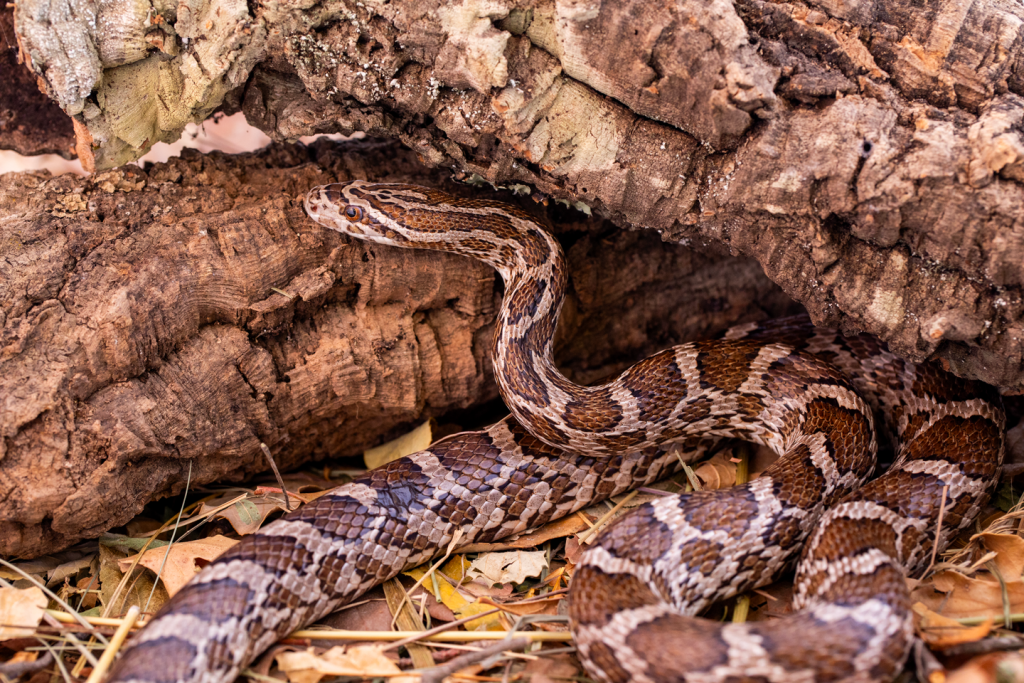
Physical description
This is another blotched snake that is usually a light brown color or a grayish color. The Great Plains rat snake also has a smaller series of blotches on the sides that alternate with the blotches on the back. The belly of this snake is a creamy white color, normally with a checkerboard pattern.
Size
Adult Great Plains rat snakes can range from 28-46 inches long.
Habitat
These snakes are fond of limestone outcroppings in open grasslands. These snakes avoid densely wooded areas, but like hillsides and canyons with occasional woody areas.
Range in Nebraska
In Nebraska, these snakes are found in the Southeast and central counties that border the state of Kansas, only around 15 miles north.
Diet
These snakes are constrictors and feed on rodents, small mammals, birds and eggs, and sometimes lizards.
Fun Facts
>> Great Plains rat snakes often hibernate with many other species in rocky outcrop areas.
>> At one time, the Great Plains rat snake was considered a sub species of the corn snake, but recently they have been characterized as their own species.
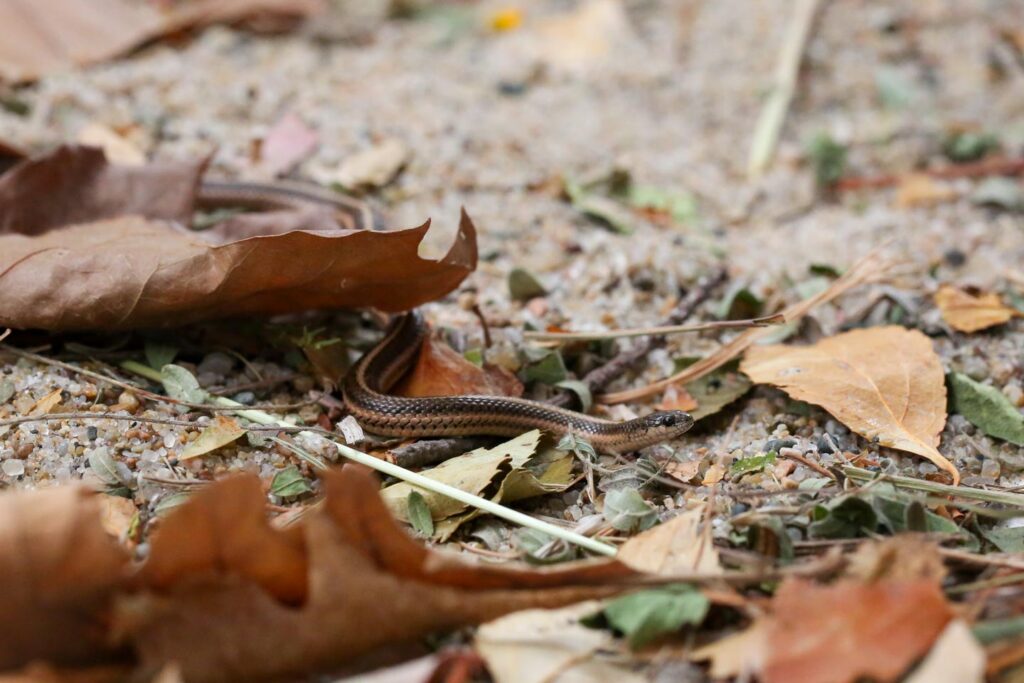
Physical description
The lined snake looks similar to garter snakes, but they are different. The normal color for this animal is a coffee brown to gray color with a light-colored stripe in the middle of the back. This snake also has light-colored horizontal lines running along the sides of the snake. Their belly is a white color with half-moon shaped patterns on each scale.
Size
Adult lined snakes only reach 8-12 inches in length.
Habitat
These snakes can be found in prairies and other grasslands, such as savannas. More often than not, these snakes are in areas with wetlands. They can even be common in urban areas under trash and debris piles.
Range in Nebraska
In Nebraska, this snake is found in counties that border the Platte River, mostly in the southeast part of the state.
Diet
This snake mostly eats invertebrates such as earthworms and isopods.
Fun Facts
>> This snake is considered fossorial, where it spends a lot of its time underneath rocks or in underground mammal burrows.
>> Lined snakes are very secretive in the spring, but are more abundantly seen in the fall.
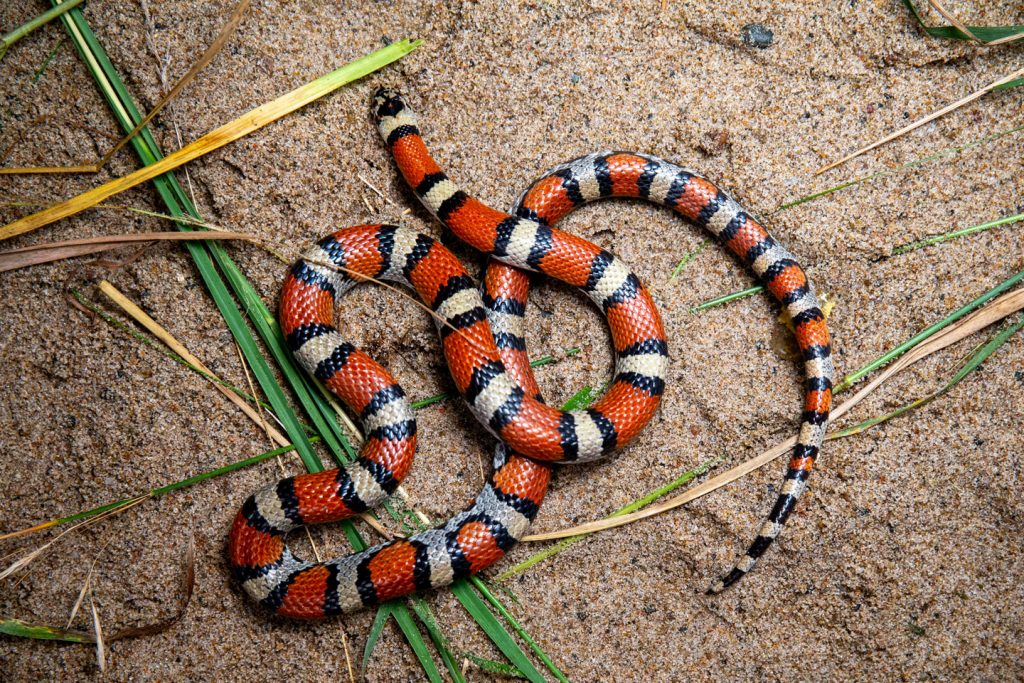
Physical description
The Milk snake’s pattern and colors can vary greatly depending on the area they are found. However, they are consistently found to have bands of black, white (or yellow) and red (or orange) throughout their body. These snakes are closely related to kingsnakes, a key characteristic being their head is continuous with the neck, and their extremely smooth scales.
Size
In Nebraska these snakes rarely exceed 36 inches. They normally range in size from 24-30 inches long.
Habitat
The Milk snake prefers grassland habitats with rocks, such as limestone, for cover and shelter. These snakes can also be found along woodland edges in decomposing trees and logs.
Range in Nebraska
These snakes can be found sporadically throughout the state.
Diet
Milk snakes commonly feed on lizards, other snakes, shrews, and rodents.
Fun Facts
>> The name milk snake comes from the false belief that this snake can drink milk from a cow’s udder.
>> Milk snakes (found in Nebraska/non-venomous) and coral snakes (not in Nebraska/venomous), look almost identical. However, the difference is in the order of the colors on their body. The rhyme goes “If red touches black, you’re okay, Jack; if red touches yellow, you’re a dead fellow.”
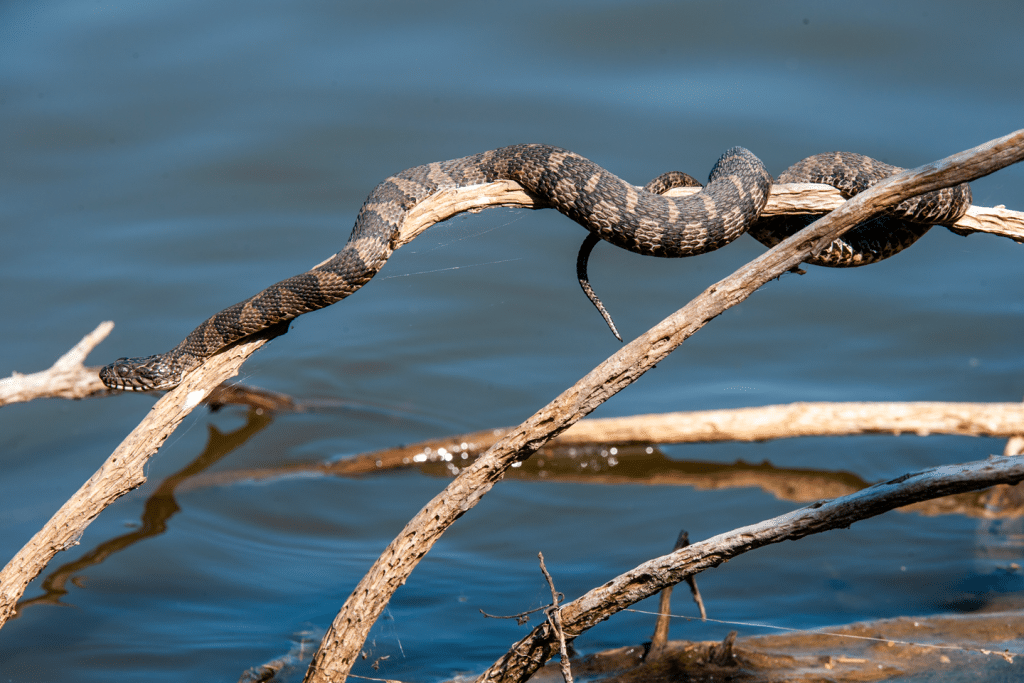
Physical description
The northern water snake is normally a gray to brown color with reddish-brown markings. These markings begin as bands close to the head and then closer to the tail they become blotches. The belly pattern of this snake consists of red and black crescent shapes that become darker toward the tail. As the snake ages, the pattern may become less noticeable.
Size
As adults northern water snakes usually reach around 36-44 inches in length.
Habitat
As their name implies, northern water snakes like water; this includes permanent ponds, lakes, and streams. They are even known to visit backyard garden ponds.
Range in Nebraska
These snakes can be found sporadically throughout the eastern two-thirds of the state.
Diet
These snakes feed mostly on fish, and amphibians, but are also known to eat small mammals and nesting and young birds as well.
Fun Facts
>> The northern water snake is often confused with the water moccasin/cottonmouth as they have similar markings and colorings as well as behaviors. However, the water moccasin/cottonmouth is not found in Nebraska.
>> These snakes give live birth unlike many other snakes that lay eggs.
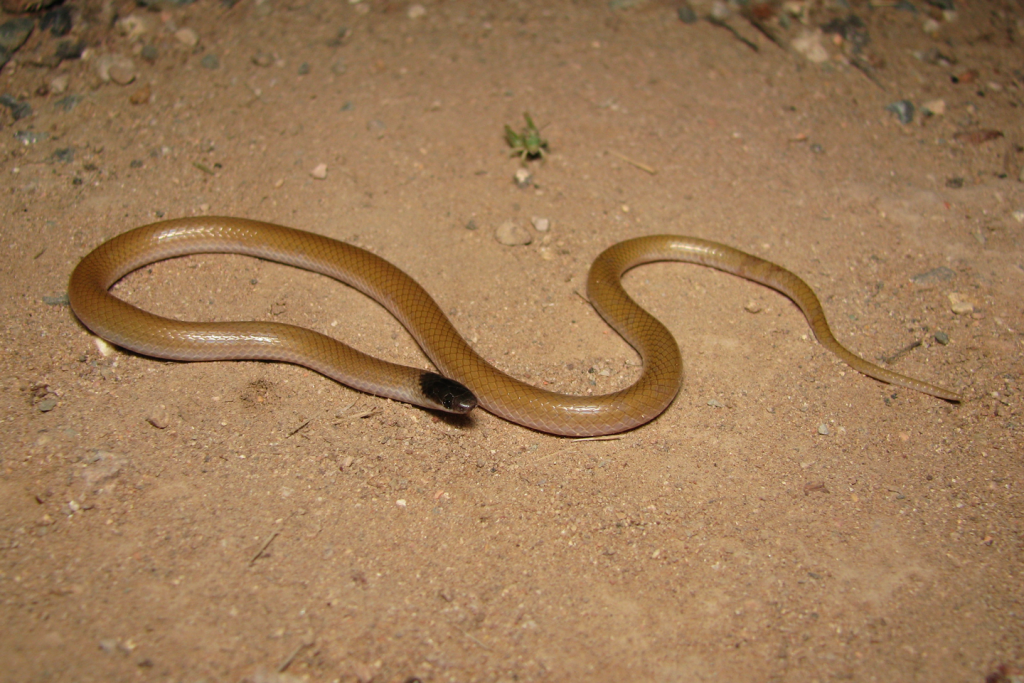
Physical description
This small snake is mostly tan or yellowish in color with a creamy white belly. Like its name implies, this snake has a dark black or brown mark on the head that extends and stops at the neck. The Plains blackhead snake also has a fairly pointed head, which helps with burrowing underground.
Size
Plains blackhead snakes rarely exceed 12 inches long.
Habitat
These snakes prefer sandy prairies and desert grassland areas. They also can be found in rocky hillsides and woodlands with sparse vegetation. Wherever they are, their habitat needs to contain moist soil.
Range in Nebraska
The Plains blackhead snake is limited to the southwest corner of the state.
Diet
This snake is actually considered a mildly venomous, rear-fanged snake. However, their venom is not a threat to humans, but instead used to slow down its prey of insects, centipedes, and spiders.
Fun Facts
>> These snakes are considered fossorial, and usually only come to the surface of the ground after a rainstorm, when the soil becomes saturated.
>> During dry times, this snake can dig almost two feet into the soil in search of a moist area.
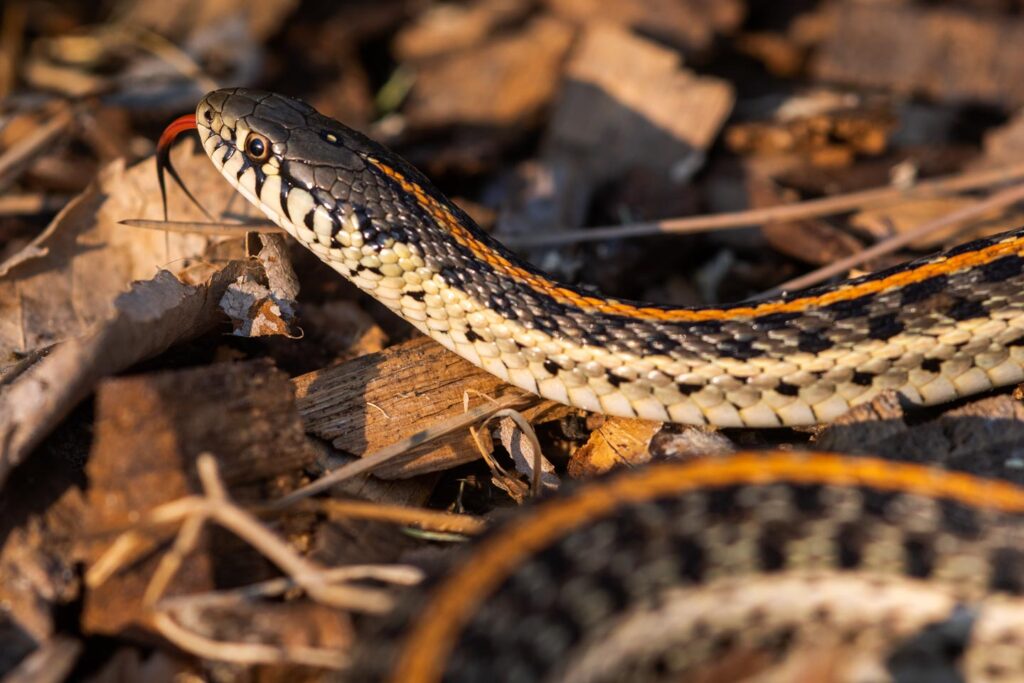
Physical description
Depending where you are in the state will depend on what this snake looks like. In the western part of Nebraska the ground color will be more green and in the eastern populations they will be red. Regardless of area and color there will be a large wide bright yellow to orange stripe that runs along the length of the back.
Size
The Plains garter snake can reach around 20-28 inches in length.
Habitat
This snake prefers areas like wet prairies and wetlands near streams, ponds, and lakes. Woodlands are usually avoided, but they can be found near edges of woodlands and riparian lands.
Range in Nebraska
These snakes can be found statewide.
Diet
Plains garter snakes will feed on amphibians, fish, earthworms, and slugs, but have also been known to eat shrews, mice and ground nesting birds.
Fun Facts
>> As with all garter snakes, females are significantly larger than males.
>> This species of garter snake usually emerges from hibernation later than other snakes.
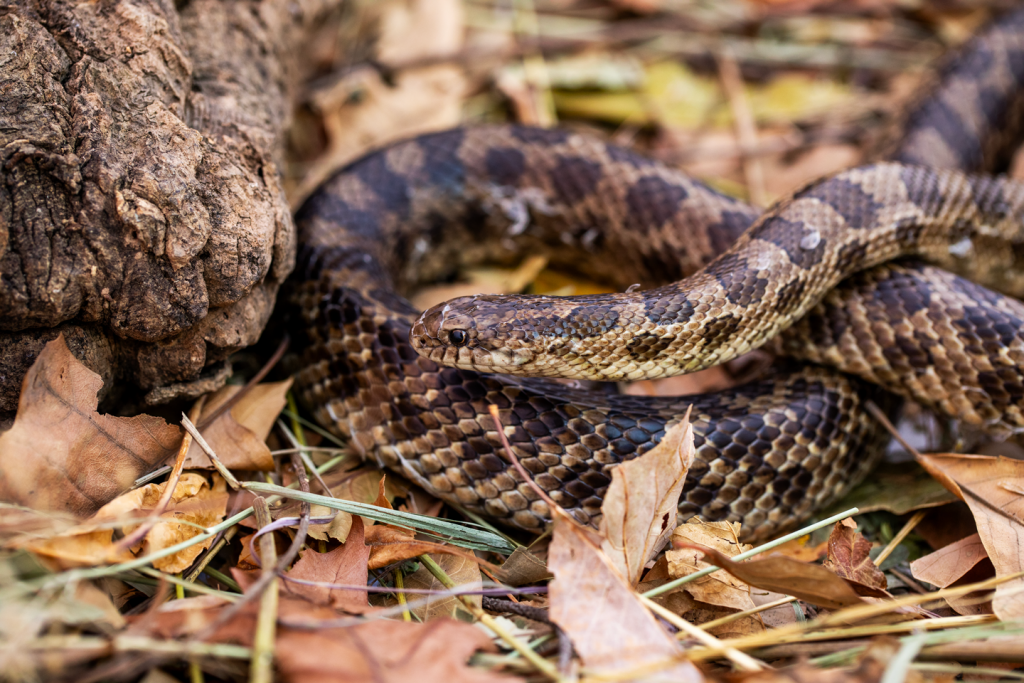
Physical description
The Prairie kingsnake has a variety of base colors that could include; a light gray, light brown, reddish-brown, or even an olive green color. A key characteristic of this snake is the distinct “V” shaped pattern on top of the head. The belly of this snake is cream colored often times with squarish dark marks.
Size
Adult Prairie kingsnakes can range in size from 32-46 inches long.
Habitat
The name of this snake helps determine where you can find them- prairies! These snakes can be found specifically in tallgrass prairies but also woodland edges, and savannas.
Range in Nebraska
The Prairie kingsnake has a limited distribution to the southeast corner of the state.
Diet
Kingsnakes normally have a reputation for eating other snakes, however, the Prairie kingsnake actually prefers voles, which is the main portion of their diet. However, they are also known to eat small mammals, bird eggs, lizards, and other snakes.
Fun Facts
>> These snakes are normally diurnal (active during the day), however, during the hot months of the summer, these snakes will switch to being nocturnal instead.
>> The Prairie kingsnake looks very similar to the Great Plains rat snake and the Western Fox snake as far as coloring and pattern.
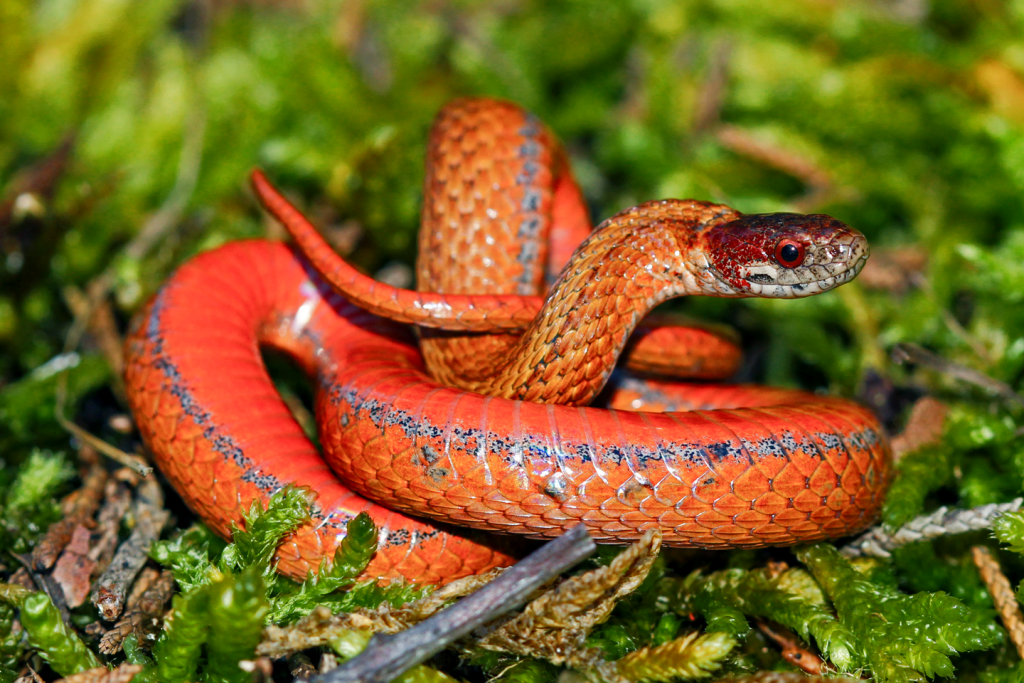
Physical description
The redbelly snake is similar to the brown snake, however this animal is light gray, brown, or a reddish color. This animal also has dark thin stripes bordering the colors. On the neck, there are usually three large light colored spots. The belly is normally a shade of red, either deep colored or light.
Size
This snake only reaches 8-11 inches long as an adult.
Habitat
This snake prefers moist woodlands and streamside habitats, ones that provide a lot of leaf litter for hiding. Redbelly snakes prefer lowland areas like those around streams and riparian woodlands, often being found under rocks, logs and other cover structures.
Range in Nebraska
The redbelly snake has only been found in Dawson, Buffalo, Hall, and Phelps counties.
Diet
This snake feeds on slugs, earthworms and sometimes insects.
Fun Facts
>> Even in cooler weather, this snake is primarily nocturnal and spends the daytime hidden beneath rocks, logs, or other structures.
>> Females will overwinter and then produce live young the following summer.
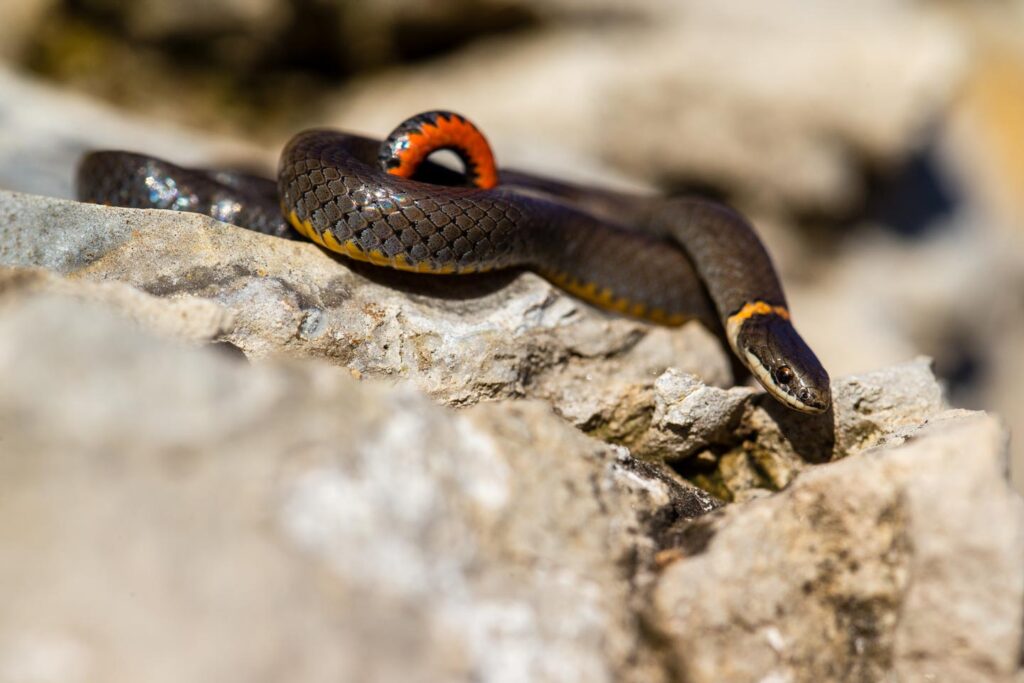
Physical description
These small snakes are normally an olive green, brown, or greenish-gray color with an orange/yellow ring, or “necklace” around their necks, giving them the name ringneck snake. These snakes then have a bright orange and yellow belly, but turns bright red toward the end of the tail. They also have black half-moon shapes speckling the bright belly colors.
Size
Ringneck snakes are one of Nebraska’s smaller snakes, only reaching around 14 inches in length.
Habitat
These snakes can be found along woodland edges, urban settings, and grasslands. More often than not, they can be found under rocks, logs, and junk piles fairly commonly and in great numbers.
Range in Nebraska
These snakes can be found sporadically throughout the eastern half of the state, but a large concentration is in the southeast corner.
Diet
These snakes prey on earthworms and small arthropods. They are rear-fanged snakes and produce a mild venom used to subdue their prey; their venom is not harmful to humans.
Fun Facts
>> In defense, these snakes will roll over and coil up their tails, showing off their bright-colored belly. Biologists think that this is a defense strategy to let would-be-predators know they are toxic if eaten.
>> In certain areas of their range, it is not uncommon to find hundreds of ringnecks under one rock, log, or other structure.
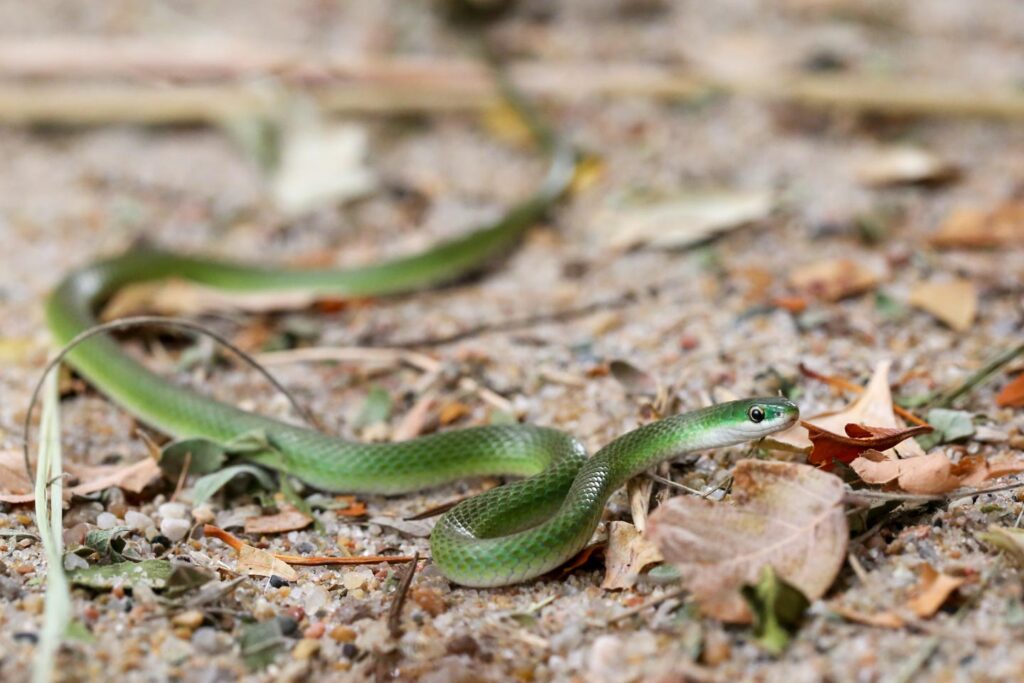
Physical Description
The name of this snake says it all, it is a smooth- scaled, solid green- colored snake with no patterns. Normally, the belly is white or bright yellow.
Size
The smooth green snake is a fairly small snake rarely exceeding 20 inches long.
Habitat
This snake can be found in meadows, wet prairies, and other moist grassland areas. They can also be found in vacant lots, roadside ditches, and even your backyard.
Range in Nebraska
Most records of this species have been from Cuming county, near West Point, Nebraska. Although other records have been found in Lincoln, Merrick, Sherman, Custer, Washington, Kearney, Franklin and Webster counties.
Diet
These snakes are primarily insectivores, however, they will also eat spiders, slugs, snails and sometimes small terrestrial salamanders.
Fun Facts
>> Females can retain eggs and incubate them internally for extended periods of time.
>> At one time the smooth green snake was considered the rarest snake in Nebraska. However, now it has an expanded distribution.
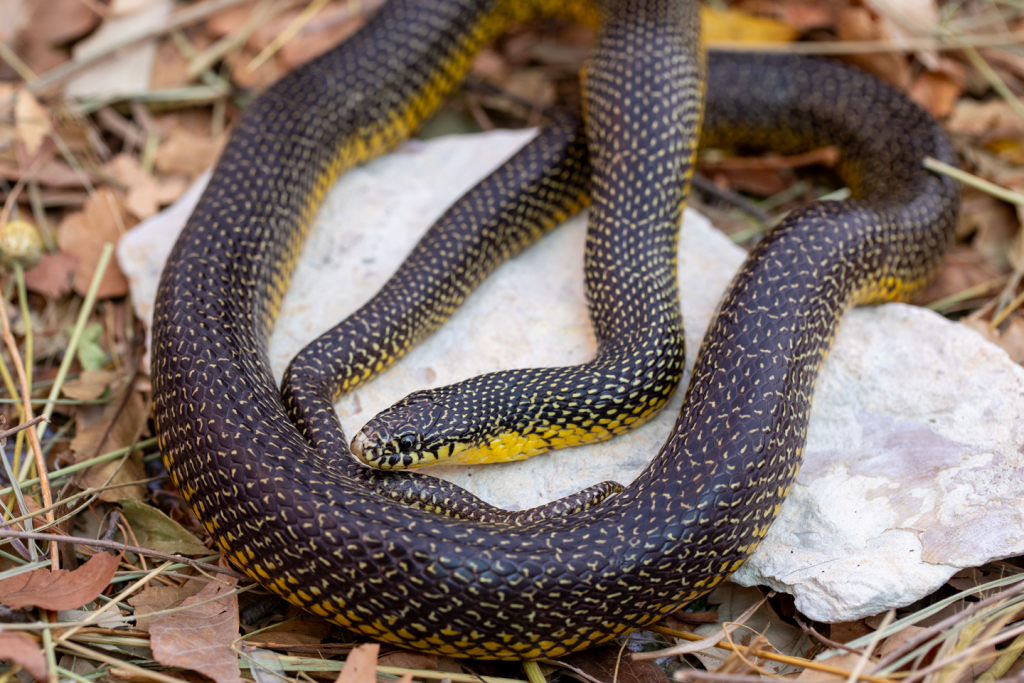
Physical description
The speckled kingsnake is extremely bright colored with a base color of either yellow, orange or white with black speckles all over the body. The belly scales are usually bright yellow to a creamy white, but can also have black spots on it as well.
Size
The adult speckled kingsnake can range from 36-48 inches long.
Habitat
This snake prefers habitats such as wet prairies, marshes, bogs, and other grassland areas with wetland associations.
Range in Nebraska
This snake is limited to five counties in Nebraska; Lancaster, Nemaha, Pawnee and Jefferson. There is also a record of this snake in Lincoln county.
Diet
The speckled kingsnake is likely to feed on other snakes as well as voles, lizards, mice, birds and eggs, and shrews.
Fun Facts
>> Once thought to be a subspecies of the common kingsnake, but recently has been deemed a completely separate species
>> Frequently “bask” on warm roads just before and after dark in the spring and fall.
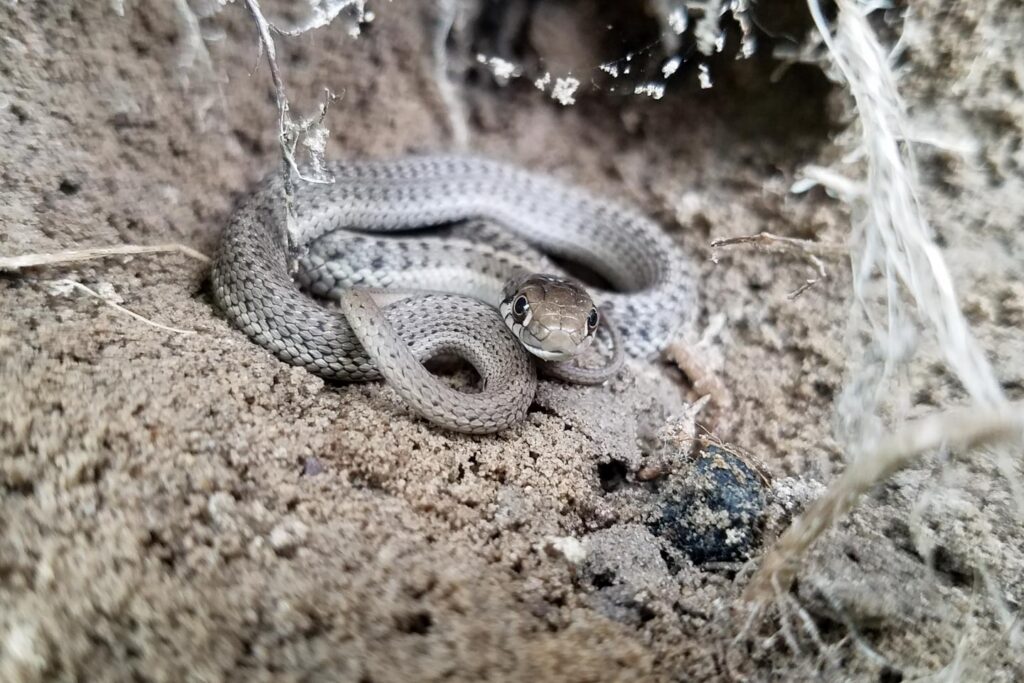
Physical description
This garter snake is normally a brown, gray or bluish-green color. A light-colored stripe runs down the length of the snake as well as dark blotches. The sides of the snake also have light-colored horizontal stripes, while the belly of the snake is black, normally toward the tail.
Size
An adult Terrestrial garter snake can reach from 20-30 inches in length.
Habitat
These snakes are normally found along streams and wet meadows.
Range in Nebraska
So far, these snakes have only been found in Sioux county Nebraska, which is in the Panhandle and Pine Ridge region of the state.
Diet
Terrestrial garter snakes will feed on fish, amphibians, earthworms, slugs, lizards, hatchling birds and small mammals.
Fun Facts
>> As with other species of garter snakes, they will give live birth.
>> These snakes are known to move great distances from water during their active season.
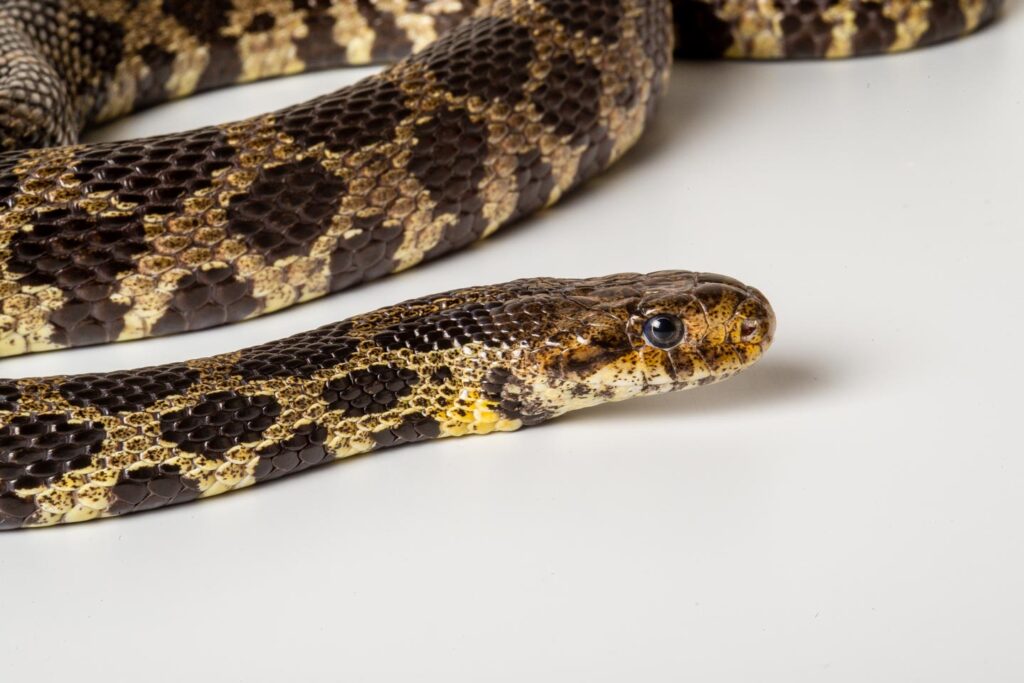
Physical description
Western fox snakes are normally a yellowish or reddish gray to brown color with darker blotches down its back. Their belly is normally a creamy white color with a checkerboard marking. As adults their head is nearly patternless, although if present, it is very light.
Size
Adult western fox snakes range in size from 36-50 inches long.
Habitat
These snakes can live in a variety of habitats including; oak savannas, grasslands, woodlands, and even farmlands. Water will nearly always be present where they are inhabiting.
Range in Nebraska
This snake can be found in the Northeastern part Nebraska.
Diet
Western fox snakes will often eat birds and bird eggs as well as small mammals, frogs, and salamanders.
Fun Facts
>> All snakes are able to shake their tail, however, western fox snakes tend to do this more often than other snakes. Occasionally these snakes are killed in people thinking they are rattlesnakes.
>> These snakes are exceptional tree climbers!
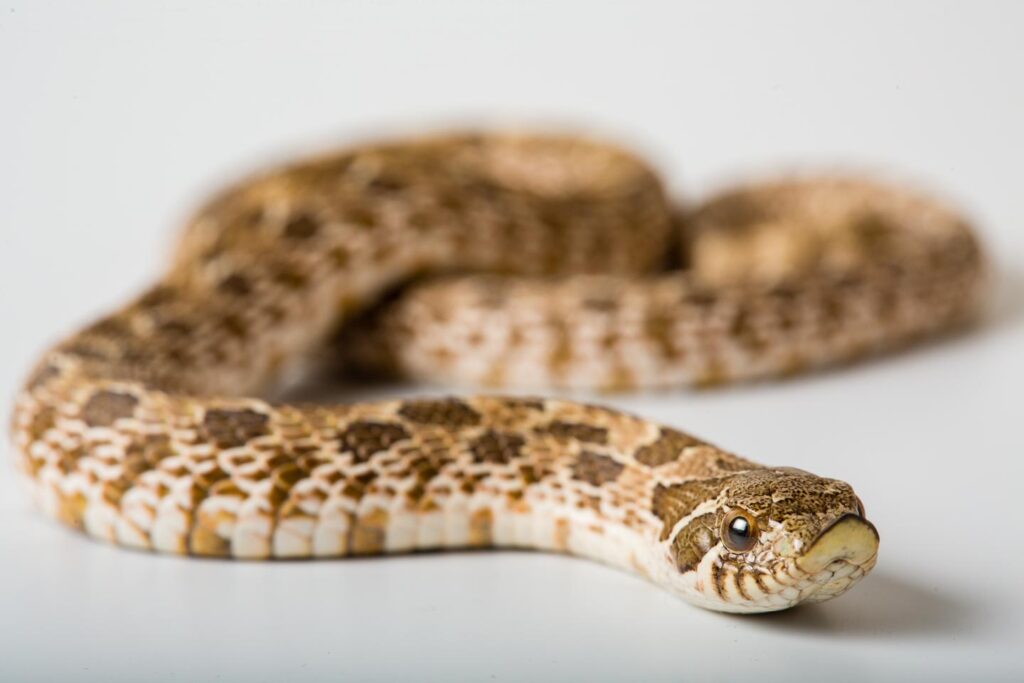
Physical description
The western hognose snake is one of two snakes in Nebraska to have a specialized upturned scale as its “nose.” This snake is normally a light or dark brown color with dark brown blotches along its body. The belly of this snake is normally black with a few lighter brown or tan squares.
Size
Compared to its eastern cousin, the western hognose snake is slightly smaller only reaching 15-25 inches long.
Habitat
These snakes prefer grasslands with sandy soil or gravel, with some type of aquatic area, such as a stream or a lake. They are also found in short and mixed-grass prairies as well as in the Sandhills.
Range in Nebraska
These snakes can be found in the western two-thirds of the state.
Diet
The western hognose snake is a rear-fanged snake with slightly toxic venom, which it uses to subdue its favorite prey: frogs and toads. However, these snakes will also eat ground-nesting birds, eggs, turtle eggs, and hatchling turtles.
Fun Facts
>> Western hognose snakes are amazing diggers, but will use abandoned mammal burrows to escape the summer heat and for hibernation.
>> When threatened, this snake will roll over on its back and hang out its tongue to fool a predator into thinking it is dead. They may also defecate (poop) and flare up their necks (similar to a cobra) in an effort to make themselves look larger.
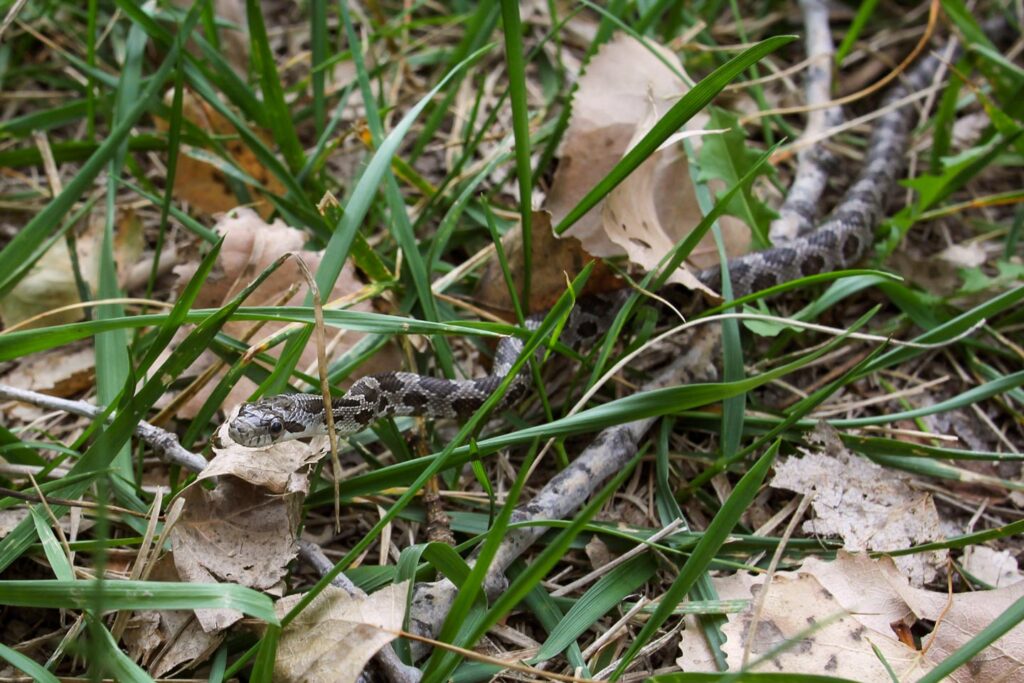
Physical description
The western rat snake, also known as the black rat snake, is almost completely black once they reach adulthood. Often times as adults you may even notice small reddish colored blotches between scales. Their belly is a creamy white color as well as their chin and neck. Young Western rat snakes look extremely different than their adult counterparts. Young snakes will be a slate gray color with dark blotches and reddish brown colorings along their back. The pattern will usually disappear by the time they reach two years old, and they will then become completely black.
Size
This is one of Nebraska’s largest snakes, reaching between 48-72 inches long.
Habitat
Western rat snakes can inhabit many different types of areas in their Nebraska range. However, they are commonly found in moist woodlands and rocky outcrops and grasslands. They can also be abundant in buildings, barns, and other man-made structures.
Range in Nebraska
The western rat snake is limited to the southeast corner of the state.
Diet
These snakes will prey on birds and bird eggs, shrews, small mammals, rodents, and small frogs.
Fun Facts
>> These snakes are considered arboreal, which means they spend a majority of their life in trees.
>> This snake is sometimes called the “pilot snake.” They get this name from the false belief that they will guide other snakes back to den sites for the winter.
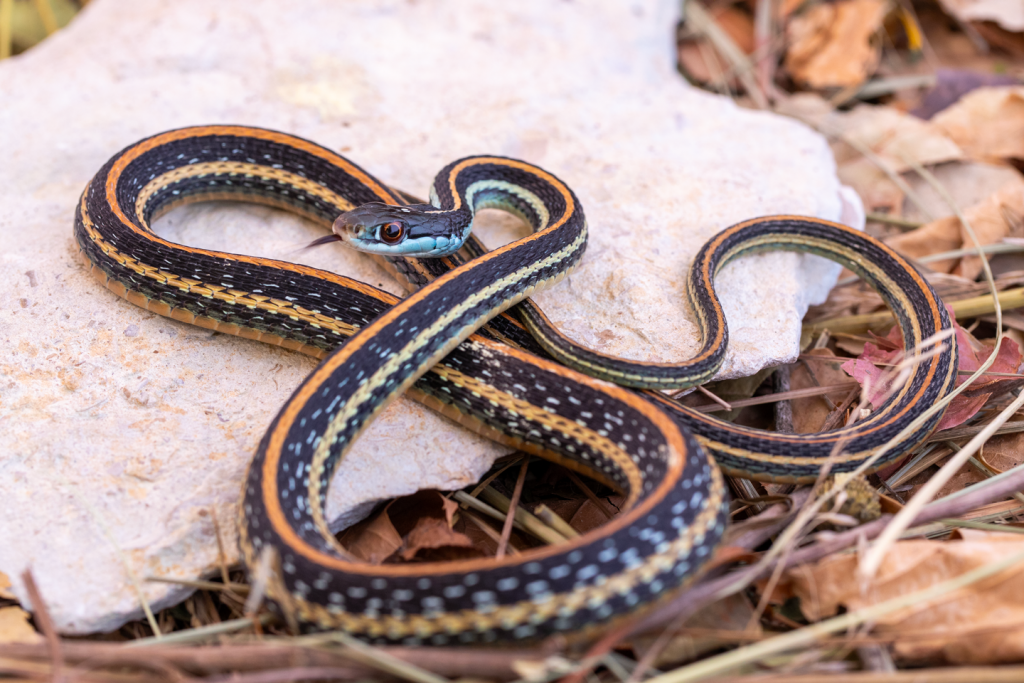
Physical description
The western ribbon snake is one of the darkest colored garter snakes in Nebraska. These snakes have an orange stripe running down the middle of their back, with white stripes on either side of the snake. The belly of these snakes is white with no pattern.
Size
Adult Western ribbon snakes can reach between 20-30 inches in length.
Habitat
These snakes can be found in wet meadows, prairies, and along the edges of lakes and ponds. If roadside ditches become permanently flooded with water, it is not unusual to see these snakes in there as well.
Range in Nebraska
This snake is limited to the southeast corner of the state.
Diet
This snake is mostly restricted to eating fish, amphibians and sometimes small lizards.
Fun Facts
>> During extreme heat these snakes will become crepuscular meaning they are most active during dawn and dusk.
>> These snakes will use crayfish burrows and small mammal burrows for hibernation.
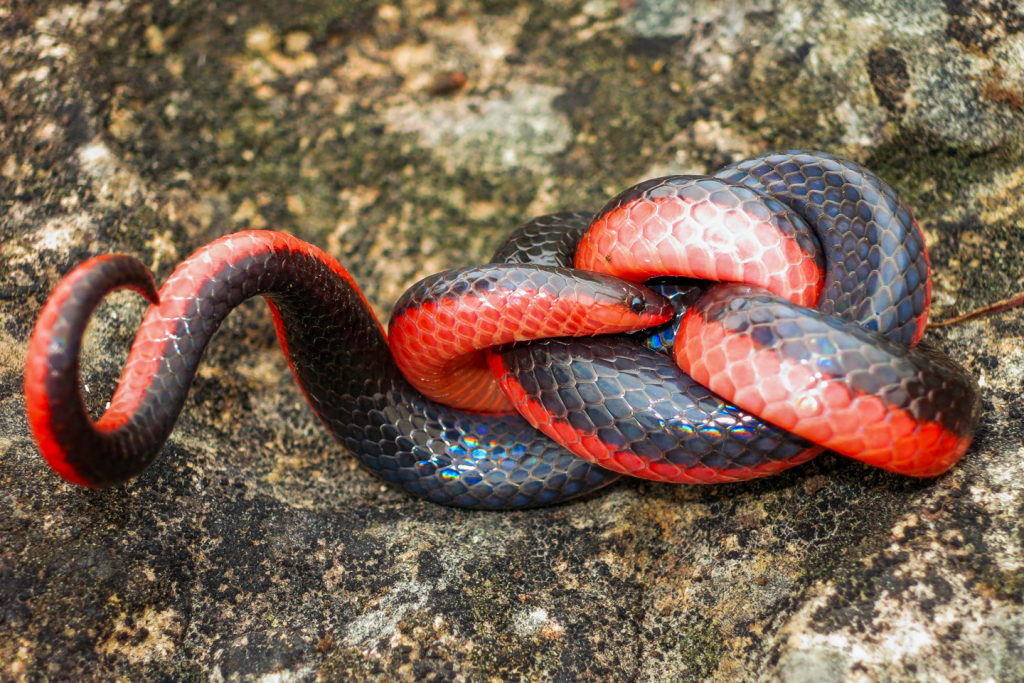
Physical description
The western worm snake is bicolored. The top half of the snake is normally a dark purple color, whereas the belly is pinkish orange, with almost a perfect line dividing the two colors. These snakes have an extremely small head, small eyes, and the tail comes to a very sharp point.
Size
Adult western worm snakes normally reach around 7-12 inches long.
Habitat
These snakes can be found in moist woodlands and wooded hillsides. They can often be found under rocks, bark, logs and leaf litter.
Range in Nebraska
These snakes are found in the extreme southeast corner of the state.
Diet
These snakes are rear-fanged and produce a mild venom, however, they are way too small to bite people, they mostly use it to subdue their prey. Their prey consists of earthworms, insect larvae and pupae, and sometimes even extremely small snakes.
Fun Facts
>> An old wives’ tale claims that the pointy end of the tail on this snake is venomous, however, this is false. The tail is actually used to stab larger predators that could possibly be a threat to them.
>> Western worm snake females only lay about 1-6 eggs, very rarely do they lay more than this.
Venomous
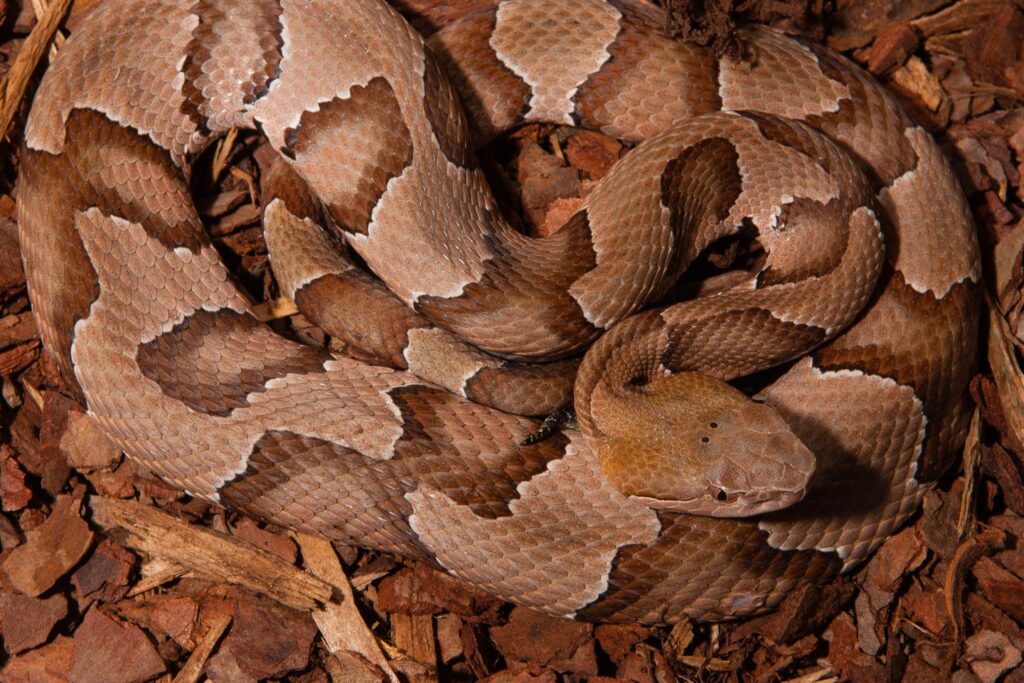
Physical description
As the name implies, copperheads are normally a copper-ish, or a light brown to reddish-tan color with a darker chestnut color cross bands along the body. In Nebraska, these crossbands are normally outlined in white. Being a pit viper these snakes have small heat-sensitive openings on each side of their head between the eye and nostril. To accommodate their venom glands their head will be much wider than the neck. Young snakes will have a greenish-yellow color on the tip of their tail, that becomes light gray as they age.
Size
Adult copperheads can reach 28-35 inches in length.
Habitat
These snakes prefer hilly and wooded areas with rocky outcrops.
Range in Nebraska
These snakes have only been found in Richardson and Gage county.
Diet
Copperheads will feed on small mammals, amphibians, reptiles, birds and insects- especially cicadas.
Fun Facts
>> These snakes will den in the same area year after year, often with many different species such as rat snakes, and rattlesnakes.
>> Although mostly a ground species, these snakes have been seen climbing on top of low bushes and shrubs to bask.
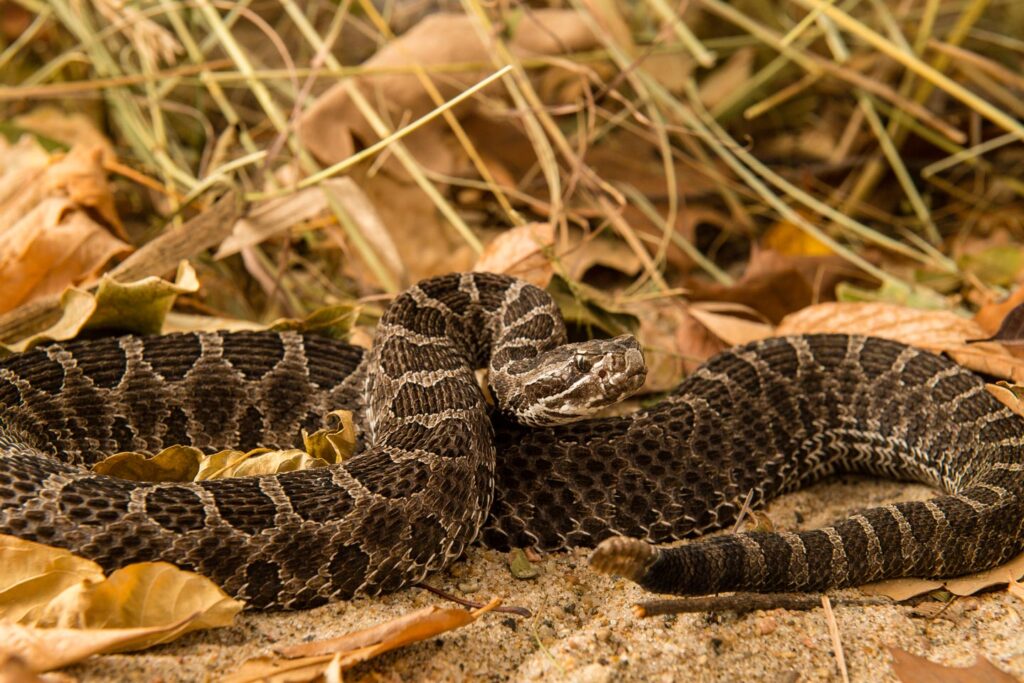
Physical description
This pit viper has a very narrow head with large scales on the back. This snake is most often confused with other non-venomous snakes. Normally, massasaugas are light gray to dark brown in color. There are also dark brown blotches down the length of the snake and become cross bands as they reach the tail.
Size
Adult massasaugas can range from 28-36 inches long.
Habitat
This snake prefers wet areas such as prairies and grasslands. One key feature that needs to be in any habitat these animals are found is crayfish burrows. Massasaugas will use them for hibernation during the winter months. Many of this snake’s natural habitat has been converted to agricultural lands so they have been reduced to live around artificial ponds and lakes.
Range in Nebraska
The massasauga is limited to the Southeast corner of the state.
Diet
Adult snakes mostly feed on voles and shrews, but have also been seen taking birds, other reptiles, amphibians and even carrion (dead animals). Young snakes will feed on other snakes and small shrews.
Fun Facts
>> This snake is sometimes called the “swamp rattler” as it is often found in marshy and wet areas in Southeast Nebraska.
>> The massasauga is protected in Nebraska and is considered a threatened species by the Nebraska Game and Parks Commission.
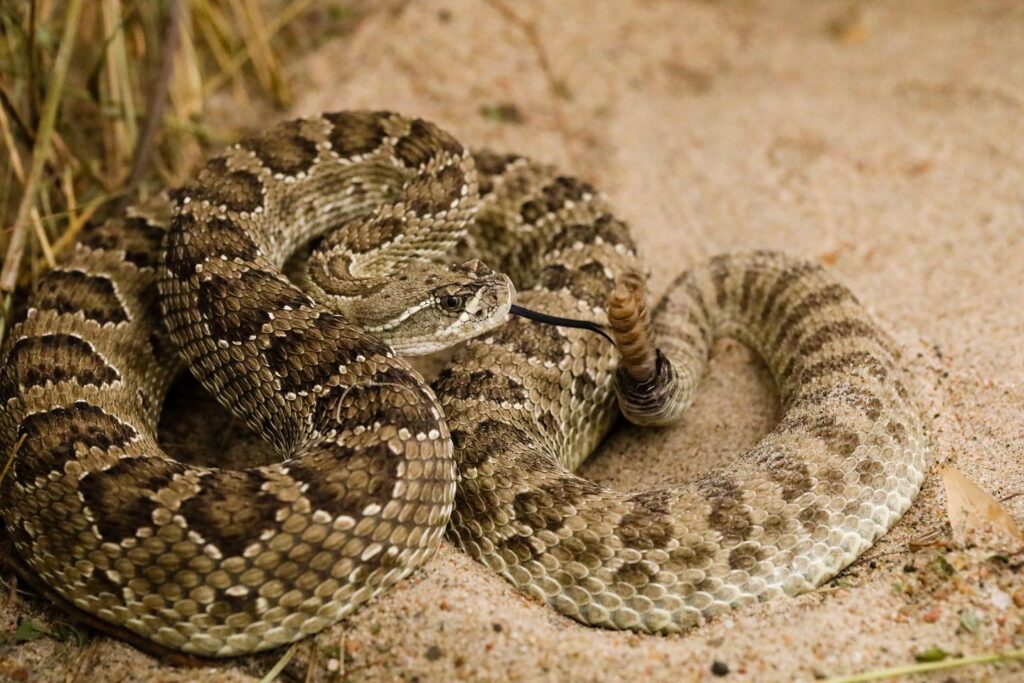
Physical description
The prairie rattlesnake is normally a greenish, light gray or sometimes brown colored snake with darker blotches running down the length of the back. The bands are darker towards the head, and turn into cross bands and become lighter towards the tail, with a rattle on the end. The face has two lighter colored lines on either side of the eyes that extend down towards their neck. The belly of the snake has no pattern and is a white or creamy color. Being a pit viper this snake has a triangular shaped head.
Size
Adult prairie rattlesnakes can range in size from 35-45 inches long.
Habitat
These snakes can be found in the mixed grass and short grass prairies in areas with rocky mesas and canyons. These snakes are usually found in association with prairie dog towns as well.
Range in Nebraska
The prairie rattlesnake can be found in the western half of the state.
Diet
This snake feeds almost exclusively on small mammals, but will also take birds, and lizards.
Fun Facts
>> When the snake is approached or threatened, they are normally quick to rattle their tail.
>> These snakes will often use prairie dog burrows as hibernation areas.
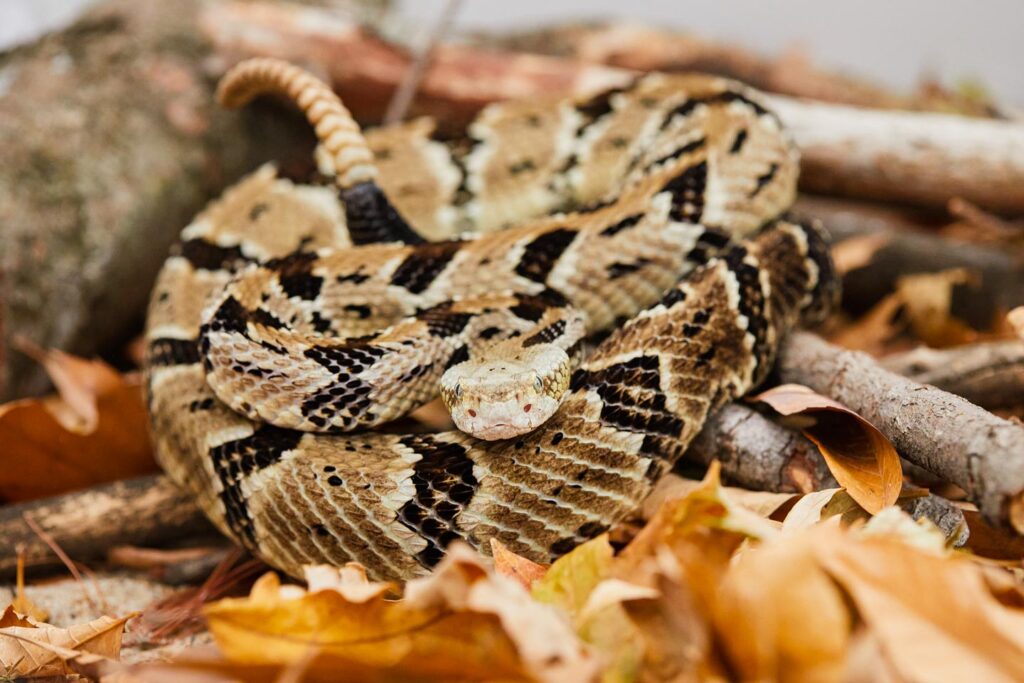
Physical description
Timber rattlesnakes are usually wither tan, gold or a light-brown color with black chevron-shaped blotches running down the length of the snake. The tail of this snake is almost always black and ending with a lighter colored rattle. Nebraska snakes will have a reddish brown stripe that extends from the head to the black tail. A gold stripe is then found either through the eyes or just under the eyes all the way from the nostrils to the cheeks.
Size
This is Nebraska’s largest rattlesnake reaching sizes from 44-60 inches long.
Habitat
These snakes prefer deciduous woodlands with areas of rocky outcroppings. Often times they can be found in woodlands along streams closer to prairies.
Range in Nebraska
Timber rattlesnakes can be found in the extreme southeastern corner of Nebraska.
Diet
Timber rattlesnakes almost exclusively feed on small mammals.
Fun Facts
>> Mating season for this snake occurs in August and September, and often times two males will combat each other to mate with a female.
>> In Nebraska, the timber rattlesnake is listed as a species in need of conservation, and has recently been moved to the Nebraska state threatened species list.
Curious for more?
Explore our pages dedicated to the reptiles, snakes and lizards, too.

